Chapter 20: Questions & Answers
1 The financial management function
The examiner's style is to test this area of the syllabus as partof a much larger question. Usually, a part (c), or part (d), you willhave to discuss or explain some of the key aspects and theirimplications.
The questions given here replicate that style.

 1. Stakeholder groups and corporate governance
1. Stakeholder groups and corporate governance
Private sector companies have multiple stakeholders who are likely to have divergent interests.
Required:
(a)Identify five stakeholder groups and briefly discuss their financial and other objectives.
(10 marks)
(b)Examine the extent to which goodcorporate governance procedures can help manage the problems arisingfrom the divergent interests of multiple stakeholder groups in privatesector companies.
(10 marks)


 2. Minicorp
2. Minicorp
Minicorp is a mining company. Its mission is to 'maximise profitsfor shareholders whilst recognising its responsibilities to society'. Itis considering a mining opportunity abroad in a remote country areawhere there is widespread poverty. The mining work will destroy localvegetation and may pollute the immediate water supply for some years tocome. The company directors believe that permission for the mining workis likely to be granted by the government as there are few people oranimals living in the area and the company will be providing much-neededjobs.
Identify the likely stakeholders in the company's decision.Consider their possible objectives and describe three likely conflictsin those objectives.
(10 marks)


 3. Not for profit and objectives
3. Not for profit and objectives
(a)Explain and comment on the problems of measuring performance in a not-for-profit organisation.
(10 marks)
(b)Discuss the objectives of a public sector organisation and how performance is measured and controlled.
(10 marks)
(c)Briefly explain the relevance ofthree measures which may be used to assess performance in public sectorservices that provide education.
(5 marks)
(Total: 25 marks)

2 Basic investment appraisal

 4. Made to order product
4. Made to order product
A company has produced a made-to-order product for a customer at acost of $50,000, which was to have been sold to the customer for$120,000.
The customer has now gone bankrupt.
The company has the option of converting the product into a different version which it estimates could be sold for $85,000.
The conversion would require the following:
(1)1,000kgs of material A. Thecompany currently has 2,500kgs in stock which was bought last month for$2.00 per kg, although the current purchase price has now increased to$2.15. Material A is regularly used in the company's other products.
(2)2,000kgs of Material B. Thecompany currently has 600kgs in stock which was bought last month for$3.00 per kg although the current purchase price is now $3.50. There isno other use for the material and it has a scrap value of $1.00 per kg.
(3)4,000 hours of skilled labour.Skilled labour is paid a fixed weekly wage and there is currently sparecapacity sufficient to provide half the required hours. The remaininghours would be made up through overtime which would be paid at $12 perhour.
(4)3,000 hours of semi skilledlabour. Semi skilled labour is paid at $6 per hour but is currentlyfully occupied on other projects. Due to union restrictions, staff willnot work overtime and there is no other labour available at such shortnotice. Therefore the only way to get the required hours is to movestaff from other production. Each hour used on this other productioncurrently generates contribution of $4 per hour (being revenue of $25,material cost of $15 and labour of $6).
(5)A machine bought for $30,000four years ago. The machine is currently being used elsewhere in thebusiness where it generates a present value of $20,000; it has a scrapvalue of $12,000. A similar replacement machine could be purchased for$15,000 and would have a zero residual value after the conversionproject.
(6)The project will take place in afactory which is currently empty. The factory is being depreciated anddepreciation for the duration of the project will be $10,000.
(7)The conversion project will be allocated a share of central overheads calculated at a rate of $4 per skilled labour hour worked.
Requirement
Perform calculations to show whether the company should convert the product.
(25 marks)

3 Investment appraisal – Discounted cash flow techniques

 5. Breccon Co
5. Breccon Co
Breccon Co introduced a new product, DV, to its range last year.The machine used to mould each item is a bottleneck in the productionprocess meaning that a maximum of 5,000 units per annum can bemanufactured.
The DV product has been a huge success in the marketplace and as aresult, all items manufactured are sold. The marketing department hasprepared the following demand forecast for future years as a result offeedback from customers.

The directors are now considering investing in a second machinethat will allow the company to satisfy the excess demand. The followinginformation relating to this investment proposal has now been prepared:

If production remained at 5,000 units, the current selling pricewould be expected to continue throughout the remainder of the life ofthe product. However, if production is increased, it is expected thatthe selling price will fall to $45 per unit for all units sold. Again,this will last for the remainder of the life of the product.
No terminal value or machinery scrap value is expected at the endof four years, when production of DV is planned to end. For investmentappraisal purposes, Breccon uses a nominal (money) discount rate of 10%per year and a target return on capital employed of 20% per year. Ignoretaxation.
Required:
(a)Calculate the following values for the investment proposal:
(i)net present value;
(ii) internal rate of return;
(iii)return on capital employed (accounting rate of return) based on initial investment; and.
(iv)discounted payback period
(14 marks)
(b)Discuss your findings in each section of (b) above and advise whether the investment proposal is financially acceptable.
(5 marks)
(c)Explain briefly the key steps that should be included in a company's capital budgeting process.
(6 marks)
(Total: 25 marks)


 6. Mutually exclusive projects
6. Mutually exclusive projects
A company is considering which of two mutually exclusive projectsit should undertake. The finance director thinks that the project withthe higher NPV should be chosen, whereas the managing director thinksthat the one with the higher IRR should be undertaken, especially asboth projects have the same initial outlay and length of life. Thecompany anticipates a cost of capital of 10%, and the net after tax cashflows of the projects are as follows:

Required:
(a)Calculate the NPV and IRR of each project.
(6 marks)
(b)Recommend, with reasons, which project you would undertake (if either).
(4 marks)
(c)Briefly explain the inconsistency in ranking of the two projects in view of the remarks of the directors.
(2 marks)
(d)Discuss the advantages anddisadvantages of the payback and accounting rate of return methods ofinvestment appraisal. Note: you are not required to perform anycalculations for these two methods; if you do, you will not score anymarks for it.
(13 marks)
(Total 25 marks)

4 Investment appraisal – Further aspects

 7. ARG Co
7. ARG Co
ARG Co is a leisure company that is recovering from a loss-makingventure into magazine publication three years ago. The company plans tolaunch two new products, Alpha and Beta, at the start of July 20X7,which it believes will each have a life-cycle of four years. Alpha isthe deluxe version of Beta. The sales mix is assumed to be constant.Expected sales volumes for the two products are as follows:

The selling price and direct material costs for each product in the first year will be as follows:

Incremental fixed production costs are expected to be $1 million inthe first year of operation and are apportioned on the basis of salesvalue. Advertising costs will be $500,000 in the first year of operationand then $200,000 per year for the following two years. There are noincremental non-production fixed costs other than advertising costs.
In order to produce the two products, investment of $1 million inpremises, $1 million in machinery and $1 million in working capital willbe needed, payable at the start of July 20X7.
Selling price per unit, direct material cost per unit andincremental fixed production costs are expected to increase after thefirst year of operation due to inflation:

These inflation rates are applied to the standard selling priceand direct material cost data provided above. Working capital will berecovered at the end of the fourth year of operation, at which timeproduction will cease and ARG Co expects to be able to recover $1.2million from the sale of premises and machinery. All staff involved inthe production and sale of Alpha and Beta will be redeployed elsewherein the company.
ARG Co pays tax in the year in which the taxable profit occurs atan annual rate of 25%. Investment in machinery attracts a first-yearcapital allowance of 100%. ARG Co has sufficient profits to take thefull benefit of this allowance in the first year. For the purpose ofreporting accounting profit, ARG Co depreciates machinery on a straightline basis over four years. ARG Co uses an after-tax money discount rateof 13% for investment appraisal.
Required:
(a)Calculate the net present value of the proposed investment in products Alpha and Beta as at 30 June 20X7.
(18 marks)
(b)Identify and discuss any likely limitations in the evaluation of the proposed investment in Alpha and Beta.
(7 marks)
(Total: 25 marks)


 8. H Co
8. H Co
H Co is considering purchasing a new machine to alleviate abottleneck in its production facilities. At present, it uses an oldmachine which can process 8,000 units of Product P per week. H couldreplace it with machine AB, which is product-specific and can produce20,000 units per week. Machine AB costs $500,000. Removing the oldmachine and preparing the area for machine AB will cost $20,000.
The company expects demand for P to be 12,000 units per week foranother three years. After this, in the fourth year, the new machinewould be sold for $50,000. This sale is not expected to take place untillater in the fourth year. The existing machine will have no scrapvalue. Each P sells for $7.00 and has a contribution to sales ratio of0.2. The company works for 48 weeks in the year. H Co normally expects apayback within two years and its after-tax cost of capital is 10% perannum.
The company pays corporation tax at 30% and receives writing-downallowances of 25%, reducing balance on the investment and any costsincurred in removing the old machine and installing the new machine.Corporation tax is payable one year in arrears.
Required:
(a)Calculate the net present value for the machine.
Make the following assumptions:
(i)The company's financial year begins on the same day that the new machine would be purchased.
(ii) The company uses discounted cash flow techniques with annual breaks only.
(14 marks)
(b)Recommend, with reasons, whether the machine should be purchased. Include any reservations you may have about your decision.
(5 marks)
(c)The investment decision in part(a) is a closely-defined manufacturing one. Explain how a marketing oran IT investment decision might differ in terms of approach andassessment.
(6 marks)
(Total: 25 marks)

5 Asset investment decisions and capital rationing

 9. Quadrant
9. Quadrant
Quadrant is a highly geared company that wishes to expand itsoperations. Six possible capital investments have been identified, butthe company only has access to a total of $620,000. The projects may notbe postponed until a future period. After the projects end, it isunlikely that similar investment opportunities will occur.
Expected net cash flows (including residual values) are:
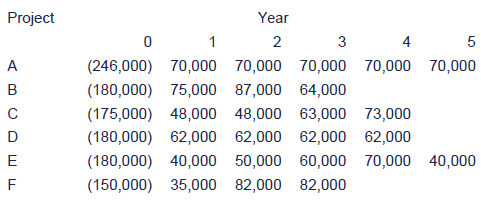
Projects A and E are mutually exclusive. All projects are believedto be of similar risk to the company's existing capital investments.
Any surplus funds may be invested in the money market to earn areturn of 9% per year. The money market may be assumed to be anefficient market.
Quadrant's cost of capital is 12% per year.
Required:
(a)Calculate the expected Net Present Value for each project, and rank the projects.
(7 marks)
(b)Assuming the projects aredivisible, calculate the profitability index for each project, and rankthe projects to determine how the money would be best invested. Explainbriefly why the rankings differ from that in (a) above.
(7 marks)
(c)Now assume the projects are indivisible. Provide advise on how the funds are best invested.
(5 marks)
(d)Explain how uncertainty and risk could be considered in the investment process.
(6 marks)
(Total: 25 marks)


 10. Ceder Co
10. Ceder Co
Ceder Co has details of two machines which could fulfil thecompany's future production plans. Only one of these machines will bepurchased.
The 'standard' model costs $50,000, and the 'de-luxe' $88,000,payable immediately. Both machines would require the input of $10,000working capital throughout their working lives, and both machines haveno expected scrap value at the end of their expected working lives offour years for the standard machine and six years for the de-luxemachine.
The forecast pre-tax operating net cash flows associated with the two machines are:

The de-luxe machine has only recently been introduced to the marketand has not been fully tested in operating conditions. Because of thehigher risk involved, the appropriate discount rate for the de-luxemachine is believed to be 14% per year, 2% higher than the discount ratefor the standard machine.
The company is proposing to finance the purchase of either machine with a term loan at a fixed interest rate of 11% per year.
Taxation at 35% is payable on operating cash flows one year inarrears, and capital allowances are available at 25% per year on areducing balance basis.
Required:
(a)to calculate for both the standard and the de-luxe machine:
(i)payback period
(ii) net present value
(14 marks)
(b)Recommend, with reasons, which of the two machines Ceder Co should purchase.
(4 marks)
(c)If Ceder Co were offered theopportunity to lease the standard model machine over a four-year periodat a rental of $15,000 per year, not including maintenance costs,evaluate whether the company should lease or purchase the machine.
(7 marks)
(Total: 25 marks)

6 Investment appraisal under uncertainty

 11. Sludgewater
11. Sludgewater
Sludgewater, a furniture manufacturer, has been reported to theanti-pollution authorities on several occasions in recent years, andfined substantial amounts for making excessive toxic discharges into theair. Both the environmental lobby and Sludgewater's shareholders havedemanded that it clean up its operations.
If no clean up takes place, Sludgewater estimates that the totalfines it would incur over the next three years can be summarised by thefollowing probability distribution (all figures are expressed in presentvalues).

A firm of environmental consultants has advised that spray paintingequipment can be installed at a cost of $4m to virtually eliminatedischarges. Unlike fines, expenditure on pollution control equipment istax-allowable via a 25% writing-down allowance (reducing balance, basedon gross expenditure).
The rate of corporation tax is 30%, paid with a one-year delay. Theequipment will have no scrap or resale value after its expected threeyear working life. The equipment can be in place ready for Sludgewater'snext financial year.
A European Union grant of 25% of gross expenditure is available,but with payment delayed by a year. The consultant's charge is $200,000and the new equipment will raise annual production costs by 2% of salesrevenue. Current sales are $15 million per annum, and are expected togrow by 5% per annum compound. No change in working capital isenvisaged.
Sludgewater applies a discount rate of 10% after tax on investmentprojects of this nature. All cash inflows and outflows occur at yearends.
Required:
(a)Calculate the expected net present value of the investment. Briefly comment on your results.
(12 marks)
(b)Outline the main limitations of using expected values when making investment decisions.
(6 marks)
(c)What financial and non-financial criteria will need to be considered when deciding whether the investment should be made.
(7 marks)
(Total: 25 marks)


 12. Pheonix
12. Pheonix
Pheonix is considering the purchase of a new machine to makewood-burning stoves. They have had a market research survey conducted ata cost of $200,000. This predicts demand of 4,000 stoves per annum at aselling price of $750 per stove for 10 years.
The machine will cost $2,000,000, payable in two instalments as follows.

Depreciation of $180,000 per annum over the next 10 years will be provided to write down the machine to its scrap value.
Use will also be made of some existing equipment which originallycost $150,000, has a book value of $75,000 and would cost $200,000 toreplace.
Pheonix is currently negotiating the sale of this machine for $100,000.
Variable cost per stove will be $600, and in accordance with thenormal policy $250,000 of fixed overheads will be apportioned to the newproduct line per annum.
The machine will require its first service one year after purchase,and from then on will be serviced every year. Each service costs$50,000.
The machine will be brought into use immediately to build upinventory, but the first revenues will not be received until 31 December20X2. Variable costs are payable annually at the same time as therevenues are received.
Required:
Calculate the following:
(a)Return on capital employed on an initial investment basis.
(3 marks)
(b)Return on capital employed on an average investment basis.
(1 mark)
(c)Payback period.
(3 marks)
(d)NPV at the company's cost of capital of 15%.
(5 marks)
(e)Internal rate of return of the project.
(3 marks)
(f)The sensitivity of your advice based on the NPV computed in (d) to errors in the estimates of
(i)the required rate of return
(ii) the selling price per unit
(iii)the level of demand.
Your answer should also include a comment on the sensitivities calculated.
(10 marks)
(Total: 25 marks)

7 Working capital management

 13. Cloud Co
13. Cloud Co
The following financial information related to Cloud Co:
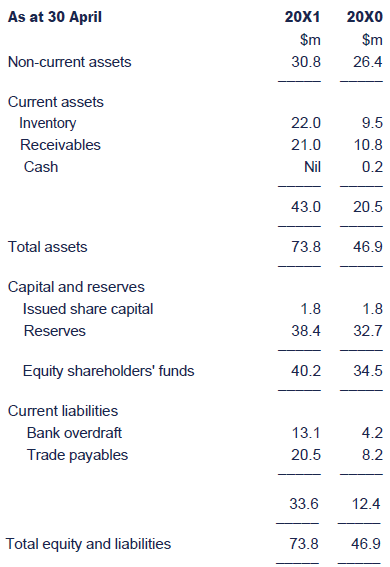
Other information
(1)Sales for the year to 30 April20X0 were $89m, yielding an operating profit of $8.7m and a profitbefore tax (after finance costs) of $8.2m.
(2)At the beginning of the year to30 April 20X1 the company bought some new manufacturing equipment andrecruited six more sales staff.
(3)Sales for the year to 30 April 20X1 were $131m, with an operating profit of $8.5m, and a profit before tax of $7m.
Required:
(a)Explain the cash conversion cycle (operating cycle) and its significance in determining the working capital needed by a company.
(4 marks)
(b)Calculate the cash operating cycle of Cloud Co for the years ending 30 April 20X0 and 20X1.
(4 marks)
(c)Using additional calculations, together with your results to part (b) discuss whether or not Cloud Co is overtrading.
(8 marks)
(d)Explain the different strategies a firm may follow in order to finance its working capital requirements.
(5 marks)
(e)Suggest ways in which Cloud Comight seek to resolve its current funding problems, and avoid the risksassociated with overtrading.
(4 marks)
(Total: 25 marks)

8 Working capital management – inventory control

 14. Hexicon
14. Hexicon
(a)Hexicon Inc manufactures andmarkets automatic washing machines. Among the many hundreds ofcomponents which it purchases each year from external suppliers forassembling into the finished article are drive belts, of which it uses40,000 units pa. It is considering converting its purchasing, deliveryand inventory control of this item to a just-in-time system. This willraise the number of orders placed but lower the administrative and othercosts of placing and receiving orders. If successful, this will providethe model for switching most of its inwards supplies on to this system.Details of actual and expected ordering and carrying costs are given inthe table below.

To implement the new arrangements will require 'one-off'reorganisation costs estimated at $4,000 which will be treated as arevenue item for tax purposes. The rate of corporation tax is 33% andHexicon can obtain finance at 12%. The effective life span of the newsystem can be assumed to be eight years.
Required:
(i)Determine the effect of the new system on the economic order quantity (EOQ).
(ii) Determine whether the new system is worthwhile in financial terms.
(12 marks)
(b)You are required to brieflyexplain the nature and objectives of JIT purchasing agreements concludedbetween components users and suppliers.
(6 marks)
(Total: 18 marks)

9 Working capital management – accounts receivable and payable

 15. Marton
15. Marton
Marton Co produces a range of specialised components, supplying awide range of customers, all on credit terms. 20% of revenue is sold toone firm. Having used generous credit policies to encourage past growth,Marton Co now has to finance a substantial overdraft and is concernedabout its liquidity.
Marton Co borrows from its bank at 13% pa interest. No furthersales growth in volume or value terms is planned for the next year.
In order to speed up collection from customers, Marton Co is considering two alternative policies:
Option one
Factoring on a non-recourse basis, the factor administering andcollecting payment from Marton Co's customers. This is expected togenerate administrative savings of $200,000 pa and to lower the averagereceivable collection period by 15 days. The factor will make a servicecharge of 1% of Marton Co's revenue and also provide credit insurancefacilities for an annual premium of $80,000.
Option two
Offering discounts to customers who settle their accounts early.The amount of the discount will depend on speed of payment as follows.
Payment within 10 days of despatch of invoices 3%
Payment within 20 days of despatch of invoices 1.5%
It is estimated that customers representing 20% and 30% of MartonCo's sales respectively will take up these offers, the remaindercontinuing to take their present credit period.
Extracts from Marton Co's most recent accounts are given below:
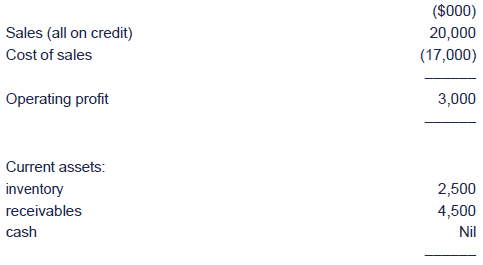
Required:
(a)Calculate the net benefit to the company of taking option 1, the non-recourse factoring arrangement.
(8 marks)
(b)Calculate the net benefit to the company of taking option 2, offering a prompt payment discount to customers.
(10 marks)
(c)Recommend which option is the most financially advantageous policy. Comment on your results.
(7 marks)
(25 marks)

10 Working capital management: cash and funding strategies

 16. Thorne
16. Thorne
Thorne Co values, advertises and sells residential property onbehalf of its customers. The company has been in business for only ashort time and is preparing a cash budget for the first four months of2006. Expected sales of residential properties are as follows.

The average price of each property is $180,000 and Thorne Cocharges a fee of 3% of the value of each property sold. Thorne Coreceives 1% in the month of sale and the remaining 2% in the month aftersale. The company has nine employees who are paid on a monthly basis.The average salary per employee is $35,000 per year. If more than 20properties are sold in a given month, each employee is paid in thatmonth a bonus of $140 for each additional property sold.
Variable expenses are incurred at the rate of 0.5% of the value ofeach property sold and these expenses are paid in the month of sale.Fixed overheads of $4,300 per month are paid in the month in which theyarise. Thorne Co pays interest every three months on a loan of $200,000at a rate of 6% per year. The last interest payment in each year is paidin December.
An outstanding tax liability of $95,800 is due to be paid in April.In the same month Thorne Co intends to dispose of surplus vehicles,with a net book value of $15,000, for $20,000. The cash balance at thestart of January 2006 is expected to be a deficit of $40,000.
Required:
(a)Prepare a monthly cash budgetfor the period from January to April 2006. Your budget must clearlyindicate each item of income and expenditure, and the opening andclosing monthly cash balances.
(10 marks)
(b)Discuss the factors to be considered by Thorne Co when planning ways to invest any cash surplus forecast by its cash budgets.
(5 marks)
(c)Discuss the advantages anddisadvantages to Thorne Co of using overdraft finance to fund any cashshortages forecast by its cash budgets.
(5 marks)
(d)Explain how the Baumol model canbe employed to reduce the costs of cash management and discuss whetherthe Baumol cash management model may be of assistance to Thorne Co forthis purpose.
(5 marks)
(Total: 25 marks)

11 Foreign exchange risk

 17. Exchange rate systems
17. Exchange rate systems
Discuss the possible foreign exchange risk and economicimplications of each of the following types of exchange rate system formultinational companies with subsidiaries located in countries withthese systems:
(a)a managed floating exchange rate
(b)a fixed exchange rate linked to a basket of currencies, and
(c)a fixed exchange rate backed by a currency board system.
(15 marks)

12 Interest rate risk

 18. Toytown
18. Toytown
Toytown is a company which distributes and sells a popular toytrain. The company, which is based in Australia, imports trains from theUSA which it packages and sells in New Zealand and larger countries inthe Far East. The company is also considering establishing a subsidiaryin South Africa which would buy products from Toytown and sell withinAfrica.
Toytown reports its results in its home currency. The company paysfor its purchases from the USA in US dollars, but receives payment forthe goods which it sells in Australasia and the Far East in localcurrency. All transactions carried out with the subsidiary in SouthAfrica would be in US dollars. The company generally takes 6 weeks topay its supplier in the USA and receives payment from debtors within 3months.
Over the last few years the company has found that sales have beenquite predictable and it has been possible to plan sales levels andpurchases of goods in advance. However, there is increasing competitionfrom companies in the Far East, which may make this more difficult inthe future.
Required:
(a)The company is currentlyconsidering whether the foreign currency exposure could be managed moreefficiently. Describe the following types of foreign currency exposure,giving examples of how they could impact Toytown, now and in the future:
(i)Economic risk
(ii) Translation risk
(iii)Transaction risk
(6 marks)
(b)Describe the followingapproaches to managing or hedging transaction exposure and thedisadvantages and advantages of each method:
(i)Leading and lagging
(ii) Matching
(iii)Forward exchange contracts
(iv)Currency options
(6 marks)
(c)Identify the factors whichToytown should consider when deciding which approach to take, and giverecommendations on how Toytown should manage its transaction exposure,giving reasons for your recommendations.
(8 marks)
(d)The company is also looking intothe financing of the establishment of the new subsidiary. The companyestimates that it will need to borrow $2 million US dollars in twomonths time for a period of six months, but is concerned about expectedfluctuation in interest rates and is considering hedging this exposureusing a forward rate agreement. The company is able to buy a 2−8 FRApriced at 5.0 – 4.7.
How could the company use this FRA to hedge the interest rateexposure, what interest would be payable and what additional sum wouldthe company have to pay to or receive from the bank if the marketinterest rate is:
(a)4%
(b)6%?
(5 marks)
(Total: 25 marks)

13 Economic environment

 19. PSBR
19. PSBR
It has been argued that the United Kingdom Public Sector BorrowingRequirement (PSBR) should be allowed to increase if a recession isforecast and held in check should the economy be likely to overheat. Incontrast, the PSBR increased during the 1970s and was held in check inthe 1980s. The United Kingdom and other countries have been assisted bythe International Monetary Fund when they have experienced balance ofpayments deficits.
Required:
(a)Explain whether and how the balance of payments and the PSBR are connected;
(7 marks)
(b)Discuss how a major refurbishment of publicly-funded hospital facilities might affect the PSBR;
(6 marks)
(c)Explain what courses of action are open to a publicly-funded hospital if it finds its funds are to be reduced.
(12 marks)
(Total: 25 marks)

14 Sources of finance

 20. G Brown
20. G Brown
G Brown is an established, listed company producing a range ofcentral heating systems for sale to builders' merchants. As a result ofincreasing demand for its products, the directors have decided to expandproduction, and therefore to raise more long term finance.
Required:
(a)Discuss the main factors whichshould be taken into account when choosing between long-term loancapital and ordinary share capital.
(12 marks)
(b)Explain the term 'convertibleloan stock'. Discuss the advantages and disadvantages of this form offinance from the viewpoint of both the company and investors.
(7 marks)
(c)Discuss the major factors which alender should take into account when deciding whether to grant along-term loan to the company.
(6 marks)
(Total: 25 marks)


 21. Bestlodge
21. Bestlodge
Bestlodge is planning to build production facilities to introduce a major new product at a cost of $12 million.
The board of directors has already approved the project on thebasis that it will yield a positive NPV when discounted, over a ten-yearperiod, at the company's market weighted average cost of capital. Theinvestment is expected to increase profit before interest and tax byapproximately 25%.
No internally-generated funds are available.
The finance director has suggested three possible sources of finance.
(1)A five-year $12 million floating rate term loan from a clearing bank, at an initial interest rate of 10%.
(2)A ten-year €16 million fixed-rate loan from the Euro-currency market at an interest rate of 7%.
(3)A rights issue at a discount of 10% on the current market price.
The company's share price is 170 cents.
The current summarised financial statements are shown below.
Summarised Statement of financial position as at 31 December 20X1
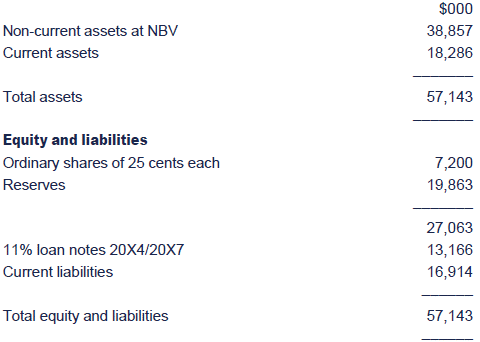
Summarised income statement for the year ended 31 December 20X1
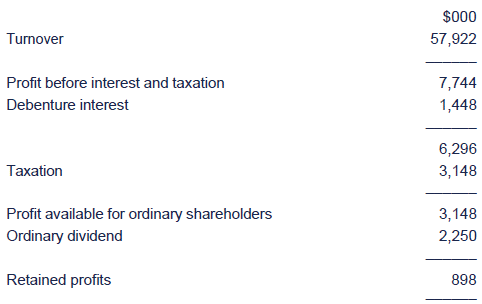
Corporation tax is at 50%
Exchange rates (€1 = $…)

Required:
Prepare a report which discusses the advantages and disadvantagesof each of the three suggested sources of finance illustrating how theutilisation of each source might affect the various providers offinance. (Relevant calculations are an essential part of your report.)
Suggest other sources of finance that might be suitable for this investment.
(25 marks)


 22. Cherry Tree Company
22. Cherry Tree Company
The Cherry Tree Company has issued 300,000 $1 par equity shares,which are at present selling for $4.40 per share. The company needs toraise additional finance in order to undertake a new project which itplans to obtain via a 2 for 5 rights issue priced at $3.00.
Required:
(a) Calculate the theoretical ex-rights price of Cherry Tree's equity shares.
(2 marks)
(b) Calculate the theoretical value of a Cherry Tree right before the shares sell ex-rights.
(2 marks)
(c) The chairman of the companyreceives a telephone call from an angry shareholder who owns 1,000shares. The shareholder argues that he will suffer a loss in hispersonal wealth due to this rights issue, because the new shares arebeing offered at a price lower than the current market value.
The chairman assures him that this wealth will not be reducedbecause of the rights issue, as long as the shareholder takesappropriate action.
Is the chairman correct? What should the shareholder do?
Prepare a statement showing the effect of the rights issue on this particular shareholder's wealth, assuming
(i)he exercises his rights
(ii) he sells all the rights
(iii)he exercises half the rights and sells the other half
(iv)he does nothing at all.
(7 marks)
(d) Are there any real circumstances which might lend support to the shareholder's claim? Explain.
(5 marks)
(e) Explain and evaluate the appropriateness of the following alternative methods of issuing equity finance:
- a placing,
- an offer for sale,
- a public offer for subscription.
(9 marks)
(Total: 25 marks)

15 Cost of capital

 23. M Co
23. M Co
The directors of M Co are considering opening a new factory tomanufacture a new product at a cost of $3.0 million. During the last 5years, the company has had 3 million shares in issue. The current marketprice of these shares (at 31 December 20X8) is $1.45 ex-dividend.
The company pays only one dividend each year (on 31 December) and dividends for the last five years have been as follows:
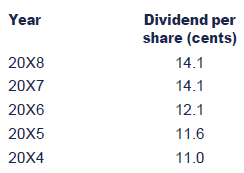
M Co currently has in issue $1 million 7% debentures redeemable on31 December 20Y2 at par. The current market price of these debentures is$83.60 ex-interest, and the interest is payable in one amount each yearon 31 December. The company also has outstanding a $500,000 bank loanrepayable on 31 December 20Y7. The rate of interest on this loan isvariable, being fixed at 3% above the bank's base rate which iscurrently 5%.
Required:
(a)Calculate the weighted average cost of capital (WACC) for M Co as at 31 December 20X8
(15 marks)
(b)Explain the terms business riskand financial risk and the significance of each in using an existingWACC to appraise a future project.
(7 marks)
(c)Briefly advise the directors of MCo on the suitability of using the WACC calculated in (a) above todiscount the expected cash flows of the project
(3 marks)
(Total: 25 marks)
Note: Ignore taxation


 24. Bacchante
24. Bacchante
Bacchante Co has a capital structure as follows:

The company's current operations are carried out from two locations.
The Oxford factory shows a cash surplus of $1,750,000 on capitalemployed of $27.5 million, while the Cambridge factory produces a cashsurplus of $640,000 on its capital of $3.5 million.
It is proposed to invest a further $1.5 million in facilities atCambridge which will increase cash flow by $150,000 to perpetuity.
Required:
(a)Calculate Bacchante's weighted average cost of capital.
(4 marks)
(b)Comment on the proposed expansion.
(6 marks)
(Total: 10 marks)
Ignore taxation.


 25. Kingswick
25. Kingswick
Kingswick Co is an all-equity financed company with a cost of capital of 18.5%.
The risk-free rate is 8% and the expected return on an average market portfolio is 15%.
It is considering the following capital investment projects:
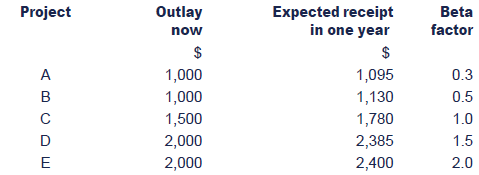
Required:
(a)Calculate Kingswick's beta factor.
(2 marks)
(b)Calculate the CAPM required return for each project.
(7 marks)
(c)Calculate the expected rate of return of each project.
(7 marks)
(d)Show which projects would beaccepted and rejected if they were discounted at the firm's cost ofcapital, and highlight those projects where an incorrect decision wouldbe made.
(9 marks)
(Total: 25 marks)

16 Capital structure

 26. AB Co
26. AB Co
AB Co has always been an all equity financed company with a cost ofcapital of 12%. The finance director has read an article extolling thebenefits of raising debt finance and has asked you to provide him withadvice as to how AB Co should finance itself for the future. He is alsointerested in what discount rate he should be using for projectappraisal. In order to assist you the finance director has helpfullycollected data on four companies which is summarised below.
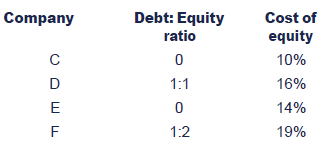
Companies C and D operate in the same industrial sector, whilstcompanies E and F both operate in a different industrial sector which isperceived as more risky than that of C and D.
All four companies and AB Co itself operate in Zee, a country that is at present a tax-free society.
You also ascertain that debt, which may be assumed to be risk-free, is currently yielding 4% per annum to investors.
Required:
(a)Comment on the data supplied bythe finance director in relation to the optimal capital structure of ABCo and advise on an appropriate discount rate for project appraisal.
(15 marks)
(b)Indicate how your advice might change if corporate taxes were introduced into Zee.
(10 marks)
Note: Your answer should address both theories of gearing.
(Total: 25 marks)

17 Financial ratios

 27. PDQ Inc
27. PDQ Inc
The directors of PDQ Inc have commissioned a firm of consultants toconduct a wide-ranging review of the company's public image and marketposition. Although this is not predominantly a financial review, theconsultants need to examine the company's financial performance.
The company has the following summary information for the last five years:
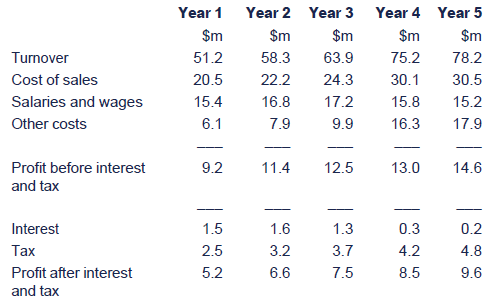

Notes
(1)Each P/E ratio is the average for the year.
(2)The increased equity in year 4was partly the result of a share issue which took place at the beginningof the year. Some of the $20m raised was used to reduce debt.
For the past five years, PDQ Inc has stated its objectives as: 'Tomaximise shareholder wealth whilst recognising the responsibility of thecompany to its other stakeholders'.
As one of the consultants working on this assignment, you have beenasked to assess whether the company has achieved its objectives in thefive-year period under review and to discuss the key factors which havedetermined your assessment.
Required:
(a)to discuss whether the company has met its objectives, based solely on the information available
(15 marks)
(b)to comment on what other financial information you would need in order to provide your client with a more accurate assessment.
(10 marks)
(Total: 25 marks)

18 Dividend policy

 28. Deerwood
28. Deerwood
The board of directors of Deerwood Inc are arguing about the company's dividend policy.
Director A is in favour of financing all investment by retainedearnings and other internally generated funds. He argues that a highlevel of retentions will save issue costs, and that declaring dividendsalways results in a fall in share price when the shares are traded exdiv. Director B believes that the dividend policy depends upon the typeof shareholders that the company has, and that dividends should be paidaccording to shareholders' needs. She presents data to the boardrelating to studies of dividend policy in the USA, and a breakdown ofthe company's current shareholders.
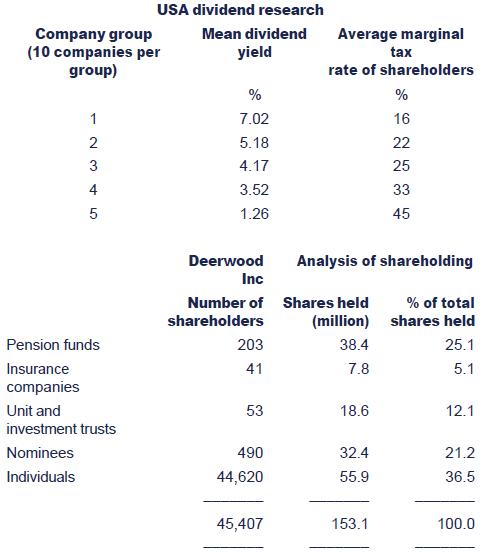
She argues that the company's shareholder 'clientele' must beidentified, and dividends fixed according to their marginal taxbrackets.
Director C agrees that shareholders are important, but points outthat many institutional shareholders and private individuals rely ondividends to satisfy their current income requirements, and prefer aknown dividend now to an uncertain capital gain in the future.
Director D considers the discussion to be a waste of time. Hebelieves that one dividend policy is as good as any other, and thatdividend policy has no effect on the company's share price. In supportof his case he cites the dividend irrelevancy theory proposed byModigliani and Miller.
Required:
Critically discuss the arguments of each of the four directorsusing both the information provided and other evidence on the effect ofdividend policy on the share price that you consider to be relevant.
(25 marks)

19 Business valuations and market efficiency

 29. Predator Co
29. Predator Co
The board of directors of Predator Co, a listed company, isconsidering making an offer to purchase Target Co, a private limitedcompany in the same industry. If Target Co is purchased it is proposedto continue operating the company as a going concern in the same line ofbusiness.
Summarised details from the most recent set of financial statements for Predator and Target are shown below:


Predator Co 50 cents ordinary shares, Target Co, 25 cents ordinary shares.
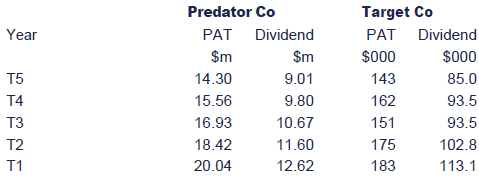
T5 is five years ago and T1 is the most recent year.
Target's shares are owned by a small number of private individuals.Its managing director who receives an annual salary of $120,000dominates the company. This is $40,000 more than the average salaryreceived by managing directors of similar companies. The managingdirector would be replaced, if Predator purchases Target.
The freehold property has not been revalued for several years and is believed to have a market value of $800,000.
The balance sheet value of plant and equipment is thought toreflect its replacement cost fairly, but its value if sold is not likelyto exceed $800,000. Approximately $55,000 of inventory is obsolete andcould only be sold as scrap for $5,000.
The ordinary shares of Predator are currently trading at 430 centsex-div. A suitable cost of equity for Target has been estimated at 15%.
Both companies are subject to corporation tax at 33%.
Required:
(a)Estimate the value of Target Co using the net asset method of valuation
(4 marks)
(b)Estimate the value of Target Co using the dividend valuation model
(7 marks)
(c)Estimate the value of Target Co using the P/E ratio method
(8 marks)
(d)Advise the board of Predator as to how much it should offer for Target's shares.
(6 marks)
(25 marks)


 30. Market efficiency statements
30. Market efficiency statements
Consider the following comments and explain the theoretical errors they contain.
The EMH says that share prices are always right. This is becauseshares move in a random fashion when new information is made public. Theonly reason prices move randomly is because of the new informationcontained in the accounts when they are published.
Both technical and fundamental analysis serve no function andcannot predict future share prices. Corporate fund managers cannotpredict share prices either.
(25 marks)

Test your understanding answers

 1. Stakeholder groups and corporate governance
1. Stakeholder groups and corporate governance
(a)Stakeholders in a companyinclude amongst others: shareholders, directors/managers, lenders,employees, suppliers and customers. These groups are likely to share inthe wealth and risk generated by a company in different ways and thusconflicts of interest are likely to exist. Conflicts also exist not justbetween groups but within stakeholder groups. This might be becausesub-groups exist, for example preference shareholders and equityshareholders within the overall category of shareholders.
Alternatively individuals within a stakeholder group might havedifferent preferences (e.g. to risk and return, short term and long termreturns). Good corporate governance is partly about the resolution ofsuch conflicts. Financial and other objectives of stakeholder groups maybe identified as follows:
Shareholders
Shareholders are normally assumed to be interested in wealthmaximisation. This, however, involves consideration of potential returnand risk. For a listed company, this can be viewed in terms of thechanges in the share price and other market-based ratios using shareprice (e.g. price/earnings ratio, dividend yield, earnings yield).
Where a company is not listed, financial objectives need to be setin terms of other financial measures, such as return on capitalemployed, earnings per share, gearing, growth, profit margin, assetutilisation, and market share. Many other measures also exist which maycollectively capture the objectives of return and risk.
Shareholders may have other objectives for the company and thesecan be identified in terms of the interests of other stakeholder groups.Thus, shareholders as a group may be interested in profit maximisation;they may also be interested in the welfare of their employees, or theenvironmental impact of the company's operations.
Directors and managers
While executive directors and managers should attempt to promoteand balance the interests of shareholders and other stakeholder groups,it has been argued that they also promote their own individual interestsand should be seen as a separate stakeholder group.
This problem arises from the divorce between ownership and control.The behaviour of managers cannot be fully observed by the shareholders,giving them the capacity to take decisions which are consistent withtheir own reward structures and risk preferences. Directors maytherefore be interested in their own remuneration package. They may alsobe interested in building empires, exercising greater control, orpositioning themselves for their next promotion. Non-financialobjectives of managers are sometimes inconsistent with what thefinancial objectives of the company ought to be.
Lenders
Lenders are concerned to receive payment of interest and eventuallyre-payment of the capital at maturity. Unlike the ordinaryshareholders, they do not share in the upside (profitability) ofsuccessful organisational strategies. They are therefore likely to bemore risk averse than shareholders, with an emphasis on financialobjectives that promote liquidity and solvency with low risk (e.g. lowgearing, high interest cover, security, strong cash flow).
Employees
The primary interests of employees are their salary/wage and theirsecurity of employment. To an extent there is a direct conflict betweenemployees and shareholders as wages are a cost to the company and incometo employees.
Performance-related pay based on financial or other quantitativeobjectives may, however, go some way toward drawing the divergentinterests together.
Suppliers and customers
Suppliers and customers are external stakeholders with their ownset of objectives (profit for the supplier and, possibly, customersatisfaction with the good or service from the customer) that, within aportfolio of businesses, are only partly dependent on the company inquestion. Nevertheless it is important to consider and measure therelationship in term of financial objectives relating to quality, leadtimes, volume of business, price and a range of other variables inconsidering any organisational strategy.
(b)Corporate governance is the system by which organisations are directed and controlled.
Where the power to direct and control an organisation is given, aduty of accountability exists to those who have devolved that power.Part of that duty of accountability is discharged by disclosure of bothperformance in the annual report and accounts and also the governanceprocedures themselves.
Corporate governance codes are usually voluntary, and operate on acomply or explain basis. Thus, any requirements are to disclosegovernance procedures in relation to best practice, rather than complywith best practice, and to explain/justify any divergence from bestpractice.
The decision-making powers in a company rest mainly with the boardof directors. Much of corporate governance regulation has thereforefocused on governance principles and best practice relating to thisstakeholder group. The principles and guidelines in the UK CombinedCode, for example, are aimed largely at trying to ensure that thedirectors act responsibly and in the interests of the other stakeholdergroups, particularly the shareholders, rather than themselves. Ideally,the interests of directors and other stakeholders should be aligned andconsistent with each other.
Some companies, such as those in the UK, have a unitary boardstructure, with one board consisting of both executive and non-executivedirectors. This contrasts with the two-tier board structure in Germanyfor instance where there is more independence between the two groups ofdirectors. In a two-tier structure, non-executives on a supervisoryboard and executive directors on a management board which reports to thesupervisory board.
Typical corporate governance proposals (such as those written into the UK Combined Code) include the following:
(1)Independence of the board with no covert financial reward
(2)Adequate quality and quantity of non-executive directors to act as a counterbalance to the power of executive directors.
(3)Remuneration committee controlled by non-executives, to decide the remuneration of the executive directors.
(4)Appointments committee consisting of non-executives, to recommend new appointments to the board.
(5)Audit committee consisting ofnon-executives, with responsibilities for audit matters, includingnegotiating the fee of the external auditors.
(6)Separation of the roles of chairman and chief executive to prevent concentration of power in one person.
(7)Full disclosure of all forms of director remuneration including shares and share options.
(8)Better communication between the board of directors and the shareholders, particularly institutional investors.
(9)Greater prominence for risk management, which is specified as a particular board responsibility.
Overall, the visibility given by corporate governance proceduresgoes some way toward discharging the directors' duty of accountabilityto stakeholders and makes more transparent the underlying incentivesystems of directors.


 2. Minicorp
2. Minicorp
Stakeholder groups would include:
potential employees, local residents, wider community,environmental pressure groups, government, company directors/managersand prestige shareholders
Possible conflicts between their objectives would include:
Local residents/ pressure groups Managers/ shareholders
Local damage will have lasting impact on the environment. Localpeople/pressure groups may consider this unacceptable whilstshareholders may think that provided compensation is paid it is areasonable consequence.
Company directors/ managers Employees/Pressure groups
Company directors may do only the minimum to comply with anyhealth and safety legislation in order to save money. Potentialemployees may be desperate for work and un-informed and may thereforetake risks with their own health. The wider community and pressuregroups will focus on employee health as a priority.
Shareholders Government
Shareholders will want to see their own wealth increased by wayof a return on their investment. The government may regard the wealth asbelonging to the country and seek to prevent profits being taken out.
Note: Again any number of possible conflicts could beidentified here. The scenario demonstrates the danger of focussing onimproving share wealth to the exclusion of all other objectives.


 3. Not for profit and objectives
3. Not for profit and objectives
(a)Not-for-profit organisationsinclude public sector bodies such as the National Health Service orlocal councils, charitable bodies e.g. Oxfam, and other organisationswhose purpose is to serve the broader community interests, rather thanthe pursuit of profit. In broad terms, such organisations seek to servethe interests of society as a whole, and so they give non-financialobjectives priority of place.
It is reasonable to argue that they best serve society's interestswhen the gap between the benefits they provide, and the cost of thatprovision is greatest. This is commonly termed value for money, and itis not dissimilar to the concept of profit maximisation, but for thefact that public welfare is being maximised rather than profit.
In practice it is incredibly difficult to quantify, for example,the benefits from an operation such as the UK's National Health Service.How does one put a value on a life which has been prolonged by 'x'number of years, or on the easing of pain which is brought about by thereplacement of an arthritic joint? The benefits extend beyond factorswhich can be measured in purely financial terms. Nonetheless, financialcriteria can be used to appraise the extent to which such organisationsoffer value for money, and hence make good use of the funds provided tothem.
The major difficulty for public sector bodies lies in precisely howto measure the achievement of the non-financial objectives. Value formoney as a concept assumes that there is a yardstick against which tomeasure success, i.e. achievement of objectives. In reality, theindicators of success are open to debate. For example, in a healthservice is success measured in terms of fewer patient deaths perhospital admission, shorter waiting lists for operations, average speedof patient recovery and so on? As long as objectives are difficult tospecify, so too will it remain difficult to specify where there is valuefor money. Comparative performance measures are useful, but care mustbe taken not to read too much into limited information.
(b)The profit motive is notapplicable in most public sector situations. Instead we must measure theservices provided, in relation to the cost of providing those services.In recent years successive governments have been concerned withmeasuring service provision. They have employed a VFM (value for money)audit that aims to get ‘the best possible combination of services fromthe least possible resources'. This is done by pursuing the three Es:
Effectiveness: this is the achievement of the objectives. Forexample, in the waste management department of a local council the taskis to collect household waste. An effective service provision will havefew customer complaints and all refuse collected on a regular basis. Inthis situation customer complaints could be a performance measure.
Economy: this is reducing costs. The organisation should have asystem of cost control to ensure that costs are kept to a minimum. Inthe past, public sector organisations in the United Kingdom had poorcost control, but more recently systems have been put in place to reducethe costs of the organisations. Performance can be measured bycalculating various cost statistics.
Efficiency: this is the achievement of objectives at minimum cost– a combination of the other two aims. For example, the local councilreferred to above may look at the cost per household to clear refuse andcompare it to what was achieved in previous years or what othercouncils have achieved. They may also look at the number of bins emptiedper day as an efficiency measure as the more emptied the lower theannual cost of this service.
(c)To ensure that the scarceresources which have been placed at their disposal are used efficientlyand effectively, public sector services such as education need to place ahigh priority on their financial control and performance. There hasalways been a quest for 'yard sticks' in such organisations, i.e. waysin which performance can be measured, compared and evaluated.
One of the measures which tends to be used in education is theamount spent on each pupil/student i.e. the cost per pupil/student foreach school or college, etc. It should be noted, however, that theamount spent per head is no indication that the amount involved has beenspent wisely and is not necessarily a measure of efficiency. It can beused in two ways:
(i)to support the view that it is possible to provide a similar service at a lower cost, or
(ii) by political parties who point to the fact that, in their areas of influence, more is spent per pupil/student on education.
Where the educational establishment provides a meals service,comparisons can be made using the cost of each meal served or on a costper pupil/student basis. Such comparisons would only be valid if themeals mix and volume of meals served were similar. Where the mealsservice was revenue earning, performance could also be evaluated usingratios for profitability, etc.
In cases where the educational establishment provides a library,cost comparisons could be made with similar sized libraries using thecost per book, or cost per pupil or cost of new books.


 4. Made to order product
4. Made to order product
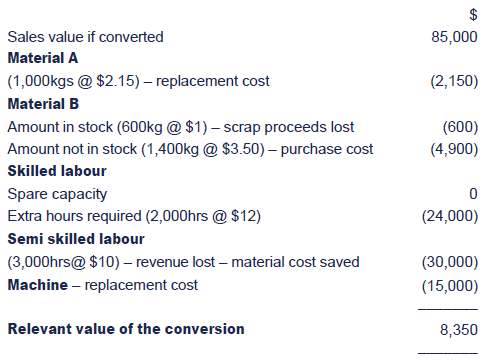
The relevant value is positive therefore the conversion should be undertaken
Note: The original order price and cost, the central overheads and the depreciation are all irrelevant


 5. Breccon Co
5. Breccon Co
(a) (i) Calculation of NPV

NPV = $7,570 > 0 therefore accept
Workings
(W1) Calculation of income

(W2) Calculation of operating costs
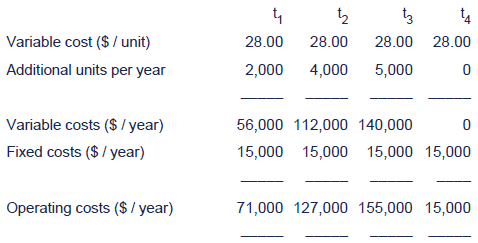
(a) (ii) Calculation of internal rate of return
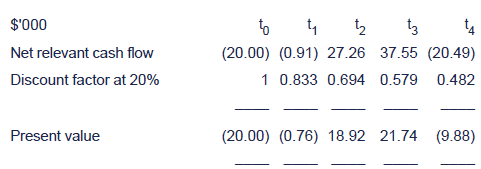
Net present value $10,020
Internal rate of return = 10 + [(23,410 / (23,410 – 10,020)) × (20 – 10)] = 10 + 8.2 = 27.5%
(a) (iii) Calculation of return on capital employed
Calculation of return on capital employed
Total cash inflow = (6,000) + 28,000 + 45,000 + (35,000) = $32,000
Total depreciation and initial investment are same, as there is no scrap value
Total accounting profit = $32,000 – $20,000 = $12,000
Average annual accounting profit = $12,000/4 = $3,000
Initial investment = $20,000
Return on capital employed = 100 x 3,000/20,000 = 15%
(a) (iv) Calculation of discounted payback

Discounted payback period = 2 + (2.32/ 33.80) = 2 + 0.07 = 2.07 years
(b)The investment proposal has apositive net present value (NPV) of $7,570 and is therefore financiallyacceptable. The results of the other investment appraisal methods do notalter this financial acceptability, as the NPV decision rule willalways offer the correct investment advice.
The internal rate of return (IRR) method also recommends acceptingthe investment proposal, since the IRR of 27.5% is greater than the 10%return required by Breccon Co. If the advice offered by the IRR methoddiffered from that offered by the NPV method, the advice offered by theNPV method would be preferred.
The calculated return on capital employed of 15% is less than thetarget return of 20%, but as indicated earlier, the investment proposalis financially acceptable as it has a positive NPV. The reason whyBreccon Co has a target return on capital employed of 20% should beinvestigated. This may be an out-of-date hurdle rate that has not beenupdated for changed economic circumstances.
The discounted payback period of 2.07 years is a significantproportion of the forecast life of the investment proposal of fouryears, a time period which the information provided suggests is limitedby technological change. The sensitivity of the investment proposal tochanges in demand and life-cycle period should be analysed, since anearlier onset of technological obsolescence may have a significantimpact on its financial acceptability.
(c)The key steps that should be included in a capital budgeting process include:
- Identification of company objectives.
- Identification of suitable projects to achieve those objectives.
- Appraisal of potential projects.
- Selection of best project.
- Making of capital expenditure in chosen project.
- Comparison of actual and planned results from project. Investigate deviations from plan where necessary. Monitoring of benefits arising from project.


 6. Mutually exclusive projects
6. Mutually exclusive projects
(a)Project X
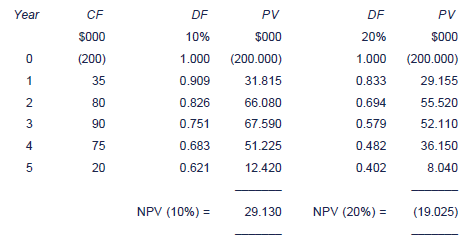

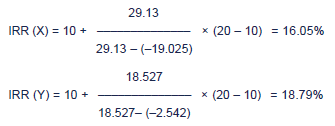
NPV (X,10%) = $29,130
NPV (Y, 10%) = $18,527
(b)Project X, when discounted atthe cost of capital 10%, has the highest NPV. However, Project Y has ahigher IRR than Project X. When a conflict arises between the NPV andIRR criteria, select the project with the highest NPV. Therefore ProjectX should be accepted in preference to Project Y.
(c)Project Y's cash flow occursmainly in year 1, whilst most of X's comes in the years 2 to 4. This isthe reason for Y's higher IRR, because the IRR calculation assumes thatany monies reinvested during the life of the project are reinvested atthe project's IRR rather than at the company's cost of capital (thelatter being the assumption of the NPV calculation).
(d)The payback period is the time taken to recover initial investment.
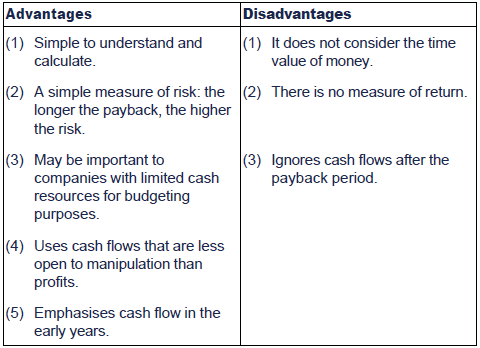
The accounting rate of return is a percentage measure. It is the ROCE of an investment.
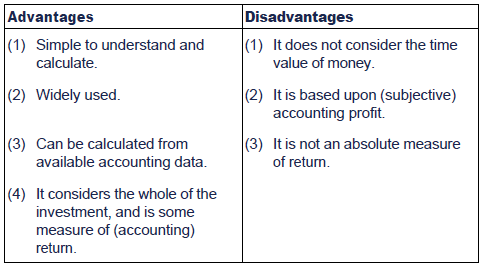


 7. ARG Co
7. ARG Co
(a)NPV calculation for Alpha and Beta
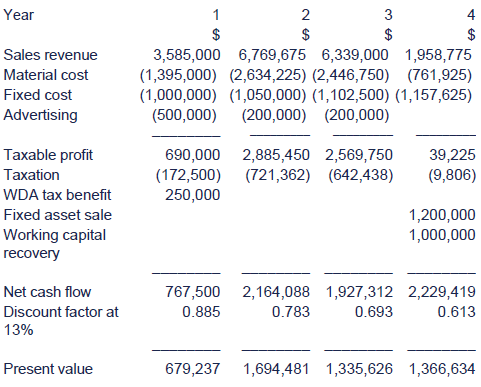

The positive NPV indicates that the investment is financially acceptable.
Workings
Alpha sales revenue
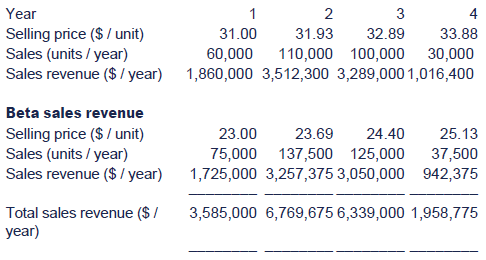
Alpha direct material cost
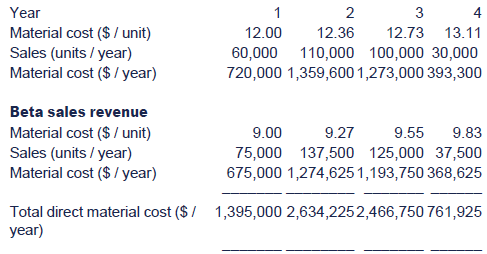
(b)The evaluation assumes thatseveral key variables will remain constant, such as the discount rate,inflation rates and the taxation rate. In practice this is unlikely. Thetaxation rate is a matter of government policy and so may change due topolitical or economic necessity.
Specific inflation rates are difficult to predict for more than ashort distance into the future and in practice are found to beconstantly changing. The range of inflation rates used in the evaluationis questionable, since over time one would expect the rates toconverge. Given the uncertainty of future inflation rates, using asingle average inflation rate might well be preferable to using specificinflation rates.
The discount rate is likely to change as the company's capitalstructure changes. For example, if the company was to fund thisinvestment entirely via debt or equity finance, the gearing of thecompany will change.
Looking at the incremental fixed production costs, it seems oddthat nominal fixed production costs continue to increase even when salesare falling. It also seems odd that incremental fixed production costsremain constant in real terms when production volumes are changing. Itis possible that some of these fixed production costs are stepped, inwhich case they should decrease.
The forecasts of sales volume seem to be too precise, predicting asthey do the growth, maturity and decline phases of the productlife-cycle. In practice it is likely that improvements or redesign couldextend the life of the two products beyond five years. The assumptionof constant product mix seems unrealistic, as the products aresubstitutes and it is possible that one will be relatively moresuccessful. The sales price has been raised in line with inflation, but alower sales price could be used in the decline stage to encouragesales.
Net working capital is to remain constant in real terms. Inpractice, the level of working capital will depend on the workingcapital policies of the company, the value of goods, the credit offeredto customers, the credit taken from suppliers and so on. It is unlikelythat the constant real value will be maintained.
The net present value is heavily dependent on the terminal valuederived from the sale of non-current assets after five years. It isunlikely that this value will be achieved in practice. It is alsopossible that the machinery can be used to produce other products,rather than be used solely to produce Alpha and Beta.


 8. H Co
8. H Co
(a)Initial investment = $500,000 + $20,000 = $520,000
Capital allowance schedule:
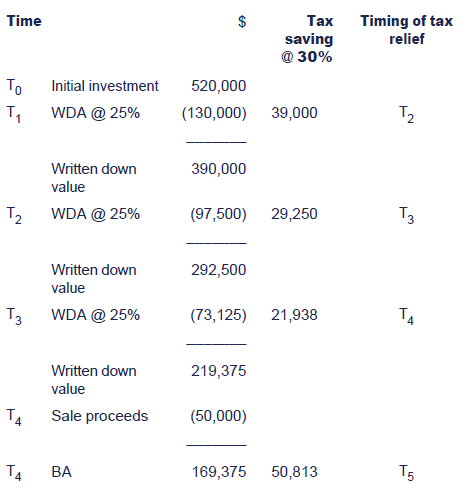
Contribution:
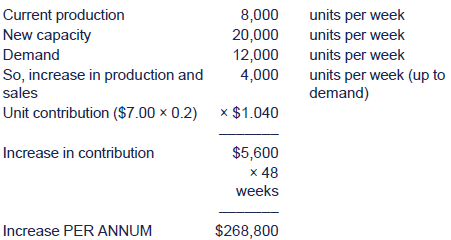
Net present value calculation ($000)
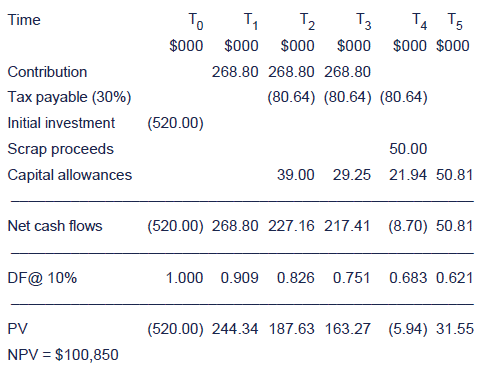
(b)The NPV is greater than zero, suggesting the project should be accepted.
The problem is the payback period = 2 years 1 month (W), which is slightly outside the company's target payback period.
Working
(W) After two years, cash inflow is $495,960. Another $24,040 isrequired for payback. In the third year, time to recover investment =24/217 × 12 = 1.3 months.
Despite the project exceeding the normal payback period of twoyears, the project should be accepted. There is a predicted NPV of$100,850 – a good return on the investment.
One reservation is that the company is purchasing a productspecific machine with a capacity far in excess of requirement. Theywould be advised to find a cheaper machine with lower capacity, whichmay give a better return.
(c)In part (a) of the question, HCo was able to calculate and measure with some degree of accuracy thenet cash benefits of purchasing the new machine. Several facts wereknown:
- the current machine capacity
- the new machine capacity
- the expected demand
- the current unit contribution.
The forecast NPV of $100,850 should be a reasonable figure that managers can have some confidence in.
Marketing and IT investment opportunities are more difficult toassess. The future benefits are difficult to quantify. If a new ITsystem is installed, how can the firm put a value on the benefits to thestaff and the company? With marketing, if customer perception and theproduct's profile improve, how can this be measured?
The benefits are often subjective, qualitative and intangible.
It is difficult to use NPV analysis to obtain a meaningful assessment of benefits.
Management will usually be aware of the (high) initial costsassociated with the IT or marketing decision. The benefits will bedescribed in a report. Often no financial benefit is predicted.
Managers must decide whether the 'improvement in corporate image'and the advancement in technology are worth the initial costs – asubjective assessment.


 9. Quadrant
9. Quadrant
(a)NPV calculations
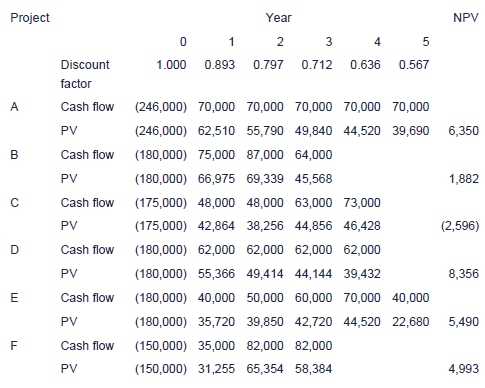
Note: Projects A and D are annuities, so it may be quicker to calculate the NPVs as follows:
Project A NPV = –$246,000 + 3.605 × $70,000 = $6,350
Project D NPV = –$180,000 + 3.037 × $62,000 = $8,294
There is a slight difference to the answer above through rounding.Either answer is acceptable. Note it will make a slight difference tosome of the answers below.
Ranking of projects:
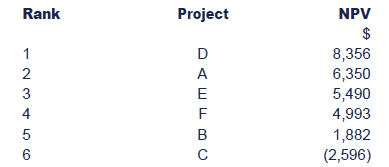
(b)Profitability index is:
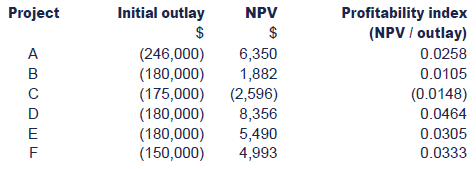
Ranking of projects:

The money should therefore be invested as follows:
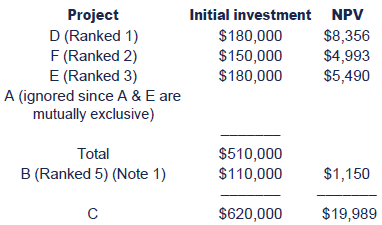
Note 1: At this point there is only $110,000 left to invest. Thiswill therefore be invested into part of project B. Given that only $110kout of $180k is being invested, the return generated will only be$1,150 ($1,882 × $110k ÷ $180k)
The rankings differ from (a) because NPV is an absolute measurewhereas the profitability index is a relative measure that takes intoaccount the different investment cost of each project.
(c)The objective is to select acombination of investments that will maximise NPV subject to a totalcapital outlay of $620,000. Projects A and E are mutually exclusive, andproject C has a negative NPV. The following are potential combinationsof projects:
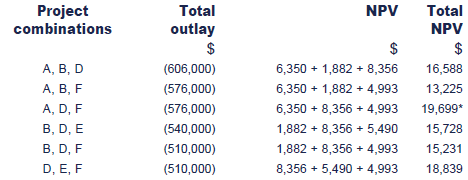
Note: It is not possible to combine four projects within theconstraints outlined above, and expected NPV cannot be increased bycombining two projects.
Accepting projects A, D and F will maximise NPV
This combination will require a total capital outlay of $576,000,and the unused funds will be invested to yield a return of 9%. Since themoney market is an efficient market, the NPV of funds invested herewill be zero.
(d)Risk and uncertainty may be considered in several ways. For example:
Adding a risk premium to the discount rate
A premium may be added to the usual discount rate to provide asafety margin. Marginally profitable projects (perhaps the riskiest) areless likely to have a positive NPV. The premium may vary from projectto project to reflect the different levels of risk.
Payback period
Estimates of cash flows several years ahead are quite likely to beinaccurate and unreliable. It may be difficult to control capitalprojects over a long period of time. Risk may be limited by selectingprojects with short payback periods.
Sensitivity analysis
Sensitivity analysis typically involves posing 'what if' questions.For example, what if demand fell by 10%, selling price was decreased by5%, etc. Alternatively, we may wish to discover the maximum possiblechange in one of the parameters before the project is no longer viable.This maximum possible change is often expressed as a percentage:

This would be calculated for each input individually. The key is to identify the relevant cash flow.
Probability distribution
A probability distribution of expected cash flows may bedetermined, and hence the expected NPV (EV) may be found together withrisk analysis e.g. best possible outcome, worst possible outcome,probability of a negative NPV. A more sophisticated measure of risk isto calculate the standard deviation. This considers the degree ofdispersion of the different possible NPVs around the expected NPV. Thegreater the spread of outcomes around the expected NPV, the higher thepotential risk. The coefficient of variation should be calculated tocompare projects.


 10. Ceder Co
10. Ceder Co
(a)Evaluation of which model should be purchased
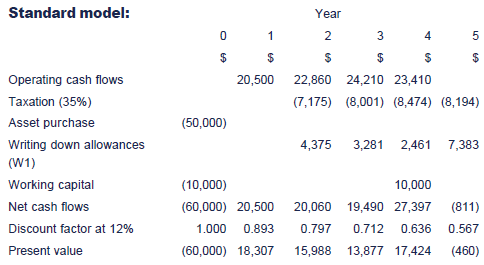
Net present value = $5,136
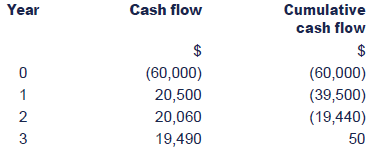
Payback = just under three years
(W1)

De-luxe model:
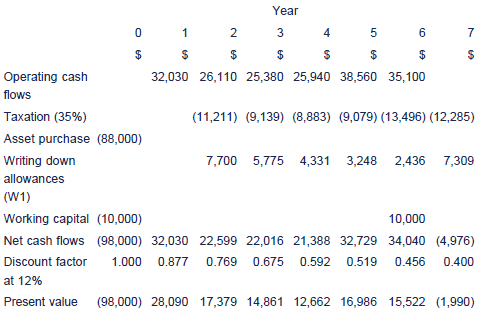
Net present value = $5,510

Payback = just under four years
(W1)

The above calculations have assumed that the assets are purchasedon the first day of the accounting period and that the working capitalis released immediately as each project ceases.
(b)Normally the project with thehighest NPV would be selected. However, as the projects have unequallives, it can be argued that although the de-luxe has a higher NPV, thisis only achieved by operating for two more years. If the machines areto fulfil a continuing production requirement the time factor needs tobe considered.
This is done by calculating the equivalent annual cash flow:
Standard model:

De-luxe model:

As the standard model has the highest equivalent annual cash flow, it is recommended that this machine be purchased.
Note: Strictly speaking, an adjustment should be made for thedifferent levels of risk associated with the two projects within theannual equivalent cost calculation. However, this is beyond the scope ofthe current F9 syllabus.
(c)Lease v buy decision
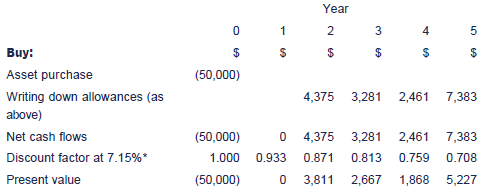
Net present value = ($36,427)
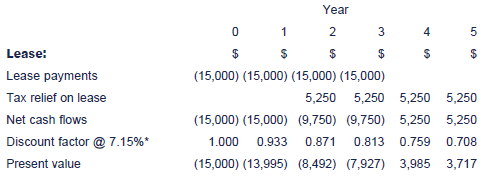
Net present value = ($37,712)
Both net present values are negative as we are just looking at thecosts of financing the projects. As the net present value of the buyingoption is less negative, it appears that the purchase of the machine isthe recommended alternative.
*The choice of discount rates in lease versus buy analysis iscontentious. The approach used here is to regard the lease as analternative to purchasing the machine using debt finance. The discountrate is, therefore, the amount that the company would have to pay on asecured loan on the machine, the loan being repayable on the terms thatare implicit in the lease rental schedule. This discount rate is theafter-tax cost of the equivalent loan, 11% (1-0.35) = 7.15%.
This discount rate is only likely to be valid if leases and loansare regarded by investors as being equivalent, and all cash flows areequally risky.


 11. Sludgewater
11. Sludgewater
(a)The expected present value of the fines is equal to:
EV = (0.3 × $1.0m) + (0.5 × $1.8m) + (0.2 × $2.6m) = $0.3m + $0.9m + $0.52m = $1.72 million.
Calculation of the net present value of the investment requirescomputation of the capital cost plus incremental production costs as setout in the following table:
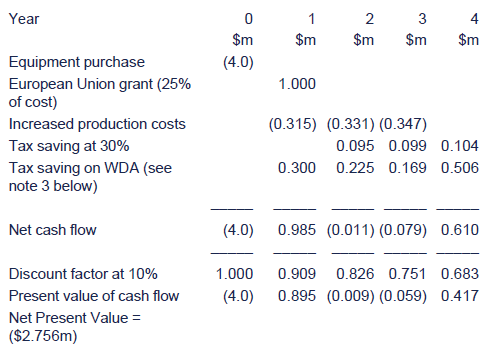
Notes:
(1)The consultant's charge has already been incurred and (as a committed cost) is therefore irrelevant to the current decision.
(2)Increased production costs

(3)Writing down allowances:

The negative NPV on the investment in spray painting equipmentexceeds the present value of the fines which Sludgewater might expect topay. It therefore seems that the project is not viable in financialterms, and it would be cheaper to risk payment of the fines. However,the company must accept that to do so might risk incurring the wrath ofboth shareholders and the environmental lobby.
(b)An expected value is calculatedby using forecast probabilities to weight the values of alternativeoutcomes and thus compute an arithmetic mean for the overall expectedresult. There are three main problems with the use of expected valuesfor making investment decisions:
(i)The investment may only occuronce. It is certainly very unlikely that there will be the opportunityto repeat the investment many times. The average of the anticipatedreturns will thus not be observed.
(ii) Attaching probabilities toevents is a highly subjective process. In investment decisions,probability may often be used in relation to sales forecasts derivedfrom market research. The subjectivity involved in setting probabilitiesmeans that the judgements may be incorrect, even though the Net PresentValue for the investment may be highly sensitive to changes in theprobability distribution.
(iii)The expected value does not evaluate the range of possible NPV outcomes.
The limitations of expected values can be demonstrated by means of asimple example. Suppose that an individual places a $10 bet with acolleague that it will rain within the next 24 hours. The weatherforecast predicts the likelihood of rain with the 24-hour period at 60%.The expected value of the bet can thus be calculated as: (0.6 * £10)– [0.4 * (£10)] = $2. In reality, the expected value can never beobserved, because the person will never be just $2 better off, only $10richer or poorer depending on the success of the bet.
(c)On purely non-financialcriteria, it can be argued that Sludgewater has a moral and communityresponsibility to install anti-pollution equipment as long as the costof installation does not jeopardise the long-term survival of thecompany.
However, the figures above suggest that the project is notwealth-creating for Sludgewater's shareholders, because the value of theexpected saving in fines ($1.72 million) is below the expected cost ofthe project ($2.756 million). The difficulty is that this conclusion isdependent on the current size of the fines payable, and if they were torise substantially, then the optimal choice (in financial terms) mightchange. The difference between the expected value of the fines and thecost of the project is currently just over $1 million. This means thatthe fines would need to rise by nearly 60% (1/1.72 × 100) before theproject becomes financially worthwhile. Changes in the size of the fineswould be very difficult to predict as it is a political issue. However,since the company is a persistent offender, and the green lobby isbecoming more influential, it is not unreasonable to anticipate that thefines will rise in the future as a result of political pressure.
It would be advisable, from a public relations perspective, for theBoard to consider alternative and perhaps less expensive anti-pollutionmeasures. It is also possible that the market for this company'sproducts might increase if it is perceived to be more environmentallyfriendly, and if customers are sensitive to this. It is even possiblethat the company's share price might benefit from managers of 'ethical'investment funds deciding to include Sludgewater shares in theirportfolio.
In addition, the company needs to think about its long-termstrategic objectives, and its stance on anti-pollution systems inrelation to these objectives. The market positioning of the company overthe longer term is likely to be affected by decisions made in the shortterm, and so even if not investing in the project makes short-termfinancial sense, it may be more attractive from a long-term viewpoint.It is also possible that technological and legal circumstances willchange over time, and such changes need to be anticipated in currentdecisions.


 12. Pheonix
12. Pheonix
(a) and (b): Return on capital employed

Average annual profit = $925,000 ÷ 10 = $92,500
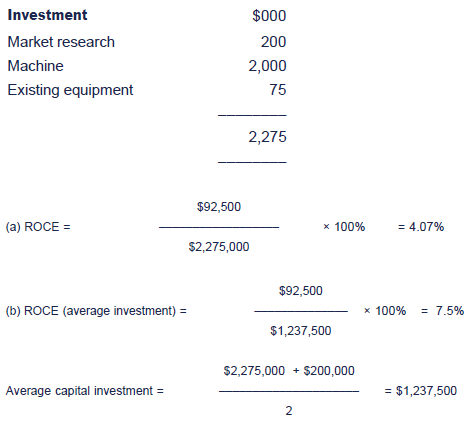
Conclusions: The ROCE can be computed in any number of ways, and sothe results must be interpreted with care, in particular when drawingcomparisons between different businesses.
(c)Payback period

Therefore, payback period = 5 years
(This assumes cash flows at the period ends, rather than accruingevenly during the year. If the cash flows accrue evenly, then payback = 4+ (500/550) = 4.9 years).

(d)NPV @ 15%
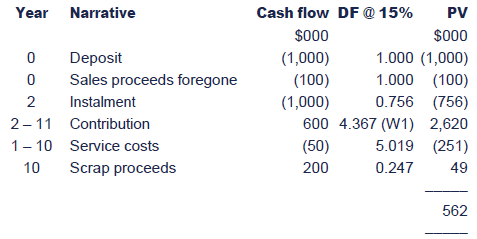
Since the NPV is positive, the project should be accepted.

(e)Internal rate of return
Since NPV @ 15% is positive, try calculating @ 20%
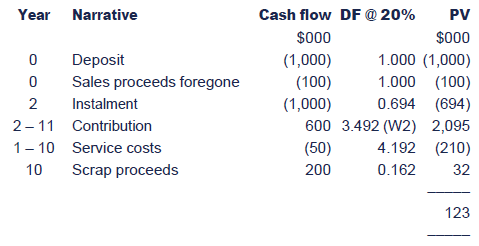
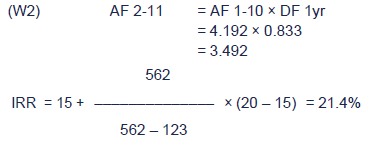
(f)Sensitivity
(i)the required rate of return

(ii) the selling price per unit
The relevant cash flow affected is the present value of sales revenue. This equals:
$750 × 4,000 units × AF2-11
= $750 × 4,000 × 4.367 = $13,101k.
Therefore:

(iii)the level of demand
The relevant cash flow affected is the present value of contribution. Therefore:

(iv)Comment on the sensitivities calculated.
The actual return is 42.7% higher than the estimated cost ofcapital. This suggests there is ample buffer and should not be a causeof concern.
The level of demand could fall by 21.4% (from 4,000 units perannum to 3,142) before the project would no longer be worthwhile. Whilstthis may seem like a relatively high margin of safety, stoves are aluxury product and will be more likely to suffer a drop in demand duringeconomic downturns. It is therefore suggested that the market researchis thoroughly reviewed to ensure the reasonableness of the conclusionsdrawn.
The greatest concern is over the selling price. If this fell bymore than 4.3% (from $750 to just $718), the project would no longer beworthwhile. Again, it is recommended that the market research report isrevisited in an attempt to assess the probability of this happening.


 13. Cloud Co
13. Cloud Co
(a)Cash conversion cycle
The cash conversion cycle (operating cycle) is the time betweenpaying out cash for purchases and receiving cash from customers. Forexample, if a raw material is purchased on credit, converted into afinished goods, then sold to a customer on credit, the operating cycleis the time between paying for those raw materials (not purchasing them)and receiving cash from the customer who bought them.
The operating cycle for a company may be calculated as follows:
Inventory days + Receivable days – Payable days
The longer the operating cycle, the more capital is tied up andthe higher the cost to finance this capital. A company could reduce theworking capital tied up by optimising the components of the cycle. So,for example, shortening the inventory days (by introducing a JIT system,for instance), shortening the receivable days (by chasing receivables)or increasing the payable days, will all shorten the operating cycle.
(b)Cash operating cycle
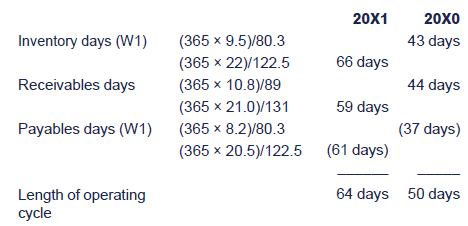
(W1) – Cost of sales
Assuming that cost of sales is the difference between sales and operating profit
2010: = $131m - $8.5m = $122.5m
2009: = $89m - $8.7m = $80.3m
(c)Financial analysis
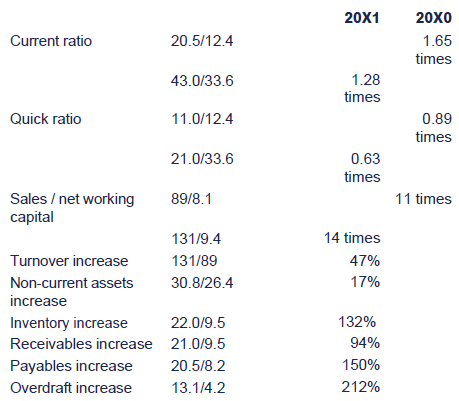
Discussion
Overtrading or undercapitalisation arises when a company has toosmall a capital base to support its level of business activity.Difficulties with liquidity may arise as an overtrading company may haveinsufficient capital to meet its liabilities as they fall due.Overtrading is often associated with a rapid increase in turnover andCloud Co has experienced a 47% increase in turnover over the last year.Investment in working capital has not matched the increase in sales,however, since the sales/net working capital ratio has increased from 11times to 14 times.
Overtrading could be indicated by a deterioration in inventorydays. Here, inventory days have increased from 43 days to 66 days, whileinventory has increased by 132% compared to the 47% increase inturnover. It is possible that inventory has been stockpiled inanticipation of a further increase in turnover, leading to an increasein operating costs.
Overtrading could also be indicated by deterioration inreceivables days. In this case, receivables have increased by 94%compared to the 47% increase in turnover. The increase in turnover mayhave been fuelled in part by a relaxation of credit terms.
As the liquidity problem associated with overtrading deepens, theovertrading company increases its reliance on short-term sources offinance, including overdraft and trade payables. The overdraft of CloudCo has more than doubled in size to $13.1 million, while trade payableshave increased by $12.3 million or 150%. Both increases are much greaterthan the 47% increase in turnover. There is evidence here of anincreased reliance on short-term finance sources.
Overtrading can also be indicated by decreases in the currentratio and the quick ratio. The current ratio of Cloud Co has fallen from1.65 times to 1.28 times, while its quick ratio has fallen from 0.89times to 0.63 times.
There are clear indications that Cloud Co is experiencing thekinds of symptoms usually associated with overtrading. A more completeand meaningful analysis could be undertaken if appropriate benchmarkswere available, such as key ratios from comparable companies in the sameindustry sector, or additional financial information from prior yearsso as to establish trends in key ratios.
(d)Financing strategies
It is important to match the funding with the life of assets. Wecan analyse assets into non-current assets, permanent current assets andfluctuating current assets. Permanent current assets, being 'core'current assets that are needed to support normal levels of sales, shouldbe financed from a long-term source. The working capital policy chosenshould take account of the relative risk of long- and short-term financeto the company and the need to balance liquidity against profitability.
An aggressive financing policy will use short-term funds tofinance fluctuating current assets as well as to finance part of thepermanent current assets. This policy is more risky, since short-termfinance is more risky than long-term, but is likely to be cheaper sinceshort-term funds usually have a lower rate of interest, and henceincrease profitability.
A conservative financing policy will use long-term funds tofinance permanent current assets as well as to finance part of thefluctuating current assets. This is less risky, but also lessprofitable.
(e)Current funding problems
Cloud Co needs to re-organise the funding of its business in a waywhich reduces its exposure to short-term debt. This could be doneeither by converting the bank overdraft into a long-term loan or byincreasing the equity investment.
Conversion of the overdraft would alter the overall level offinancial gearing within the business and so would bring some additionalrisks for both equity investors and suppliers. Increasing the equityinvestment is the better alternative. The issued share capital is lowgiven the current level of sales. However, the ability of Cloud to dothis will depend on whether the existing shareholders are willing toinvest more money or whether new shareholders could be found.
At the same time, Cloud could look carefully at its current levelsof working capital and aim to reduce the level of inventory andreceivables as a means of releasing capital. In 2010, receivables andinventory levels stood at 16.0% and 16.8% of sales value respectively.If the 2009 levels had been maintained (12.1% and 10.7%), the company'sinvestment in these two current assets could have been reduced from $43mto $30m, a saving of $13m. The cash freed up by tighter working capitalcontrols may then provide sufficient capital to pay for further salesexpansion in the future, without the need to look for additional outsidefunding.
Additionally the company could restrict further growth in order to avoid overtrading.
Cloud would appear to have exhausted its sources of workingcapital, and any further increases in sales would therefore place thecompany under a great cash strain. By reorganising its financing, andincreasing the long-term equity investment, Cloud could regain access toadditional short-term borrowing, and so avoid the risk of overtrading.


 14. Hexicon
14. Hexicon
(a)Economic order quantity:

From this it can be seen that the EOQ is halved.
(ii) The number of orders hasincreased from (40,000 ÷ 4,000) 10 orders to (40,000 ÷ 2,000) 20 orders.However, ordering costs are reduced by:
(10 × $100) – (20 × $25) = $500 per annum
Average inventories have also reduced from 2,000 units (4,000 ÷ 2) to 1,000 units (2,000 ÷ 2).
Consequently carrying costs have reduced by 20% × $2.50 × 1,000 = $500 per annum.
Total inventory costs are thereby reduced by $1,000 per annum (before tax).
Assuming that Hexicon Inc pays tax in the same year as it earnsprofits, the present value of the proposal is found by comparing theoutflow cost with the discounted after-tax savings over the eight-yearlife of the proposal (using a 12% discount rate). The after-tax savingsare $1,000 × 67% = $670.
Discounted savings:
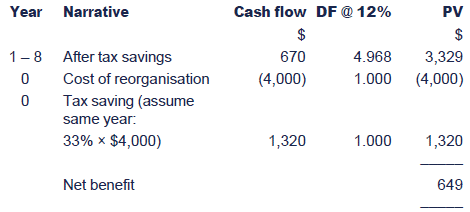
As the present value of the proposal is positive, it is worthwhile.
(b)JIT
The main objective of Just In Time (JIT) purchasing is to matchthe delivery of components from suppliers to their usage in production.If this is achieved there are significant benefits to be gained by boththe supplier and the customer.
The customer is likely to use only one supplier for each componentand to build up a relationship with the supplier which encouragescommunication thus enabling the supplier to benefit from advancedproduction planning and economies of scale. To enhance thisrelationship, the customer makes a long-term commitment to futureorders.
The supplier guarantees to deliver goods of an appropriate qualityin accordance with an agreed delivery schedule. The benefit to thecustomer is thereby a reduction (or elimination) of inventory holdingand significant cost savings. These arise in both holding costs and alsoin materials handling, because goods are transferred directly fromgoods inwards to production.


 15. Marton
15. Marton
(a)Option 1 – Factoring
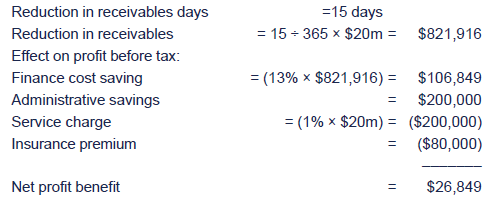
(b)Option 2 – The discount
With year-end receivables at $4.5 million, the receivables collection period was: $4.5m ÷ $20m × 365 = 82 days.
The scheme of discounts would change this as follows:
10 days for 20% of customers
20 days for 30% of customers
82 days for 50% of customers
Average receivables days become:
(20% × 10) + (30% × 20) + (50% × 82) = 49 days
Hence, average receivables would reduce from the present $4.5 million to:
49 × $20m ÷ 365 = $2,684,932
Finance cost saving = 13% × ($4.5m – $2.685m) = $235,950
The cost of the discount:
(3% × 20% × $20m) + (1.5% × 30% × $20m) = ($210,000)
The net benefit to profit before tax: $25,950
(c)The figures imply that factoringis marginally the more attractive, but this result relies on thepredicted proportions of customers actually taking up the discount andpaying on time. It also neglects the possibility that some customerswill insist on taking the discount without bringing forward theirpayments. Marton Co would have to consider a suitable response to thisproblem.
Conversely, the assessment of the value of using the factor dependson the factor lowering Marton Co's receivables days. If the factorretains these benefits for itself, rather than passing them on to MartonCo, this will raise the cost of the factoring option. The two partiesshould clearly specify their mutual requirements from the factoringarrangement on a contractual basis.


 16. Thorne
16. Thorne
(a)Cash Budget for Thorne Co:
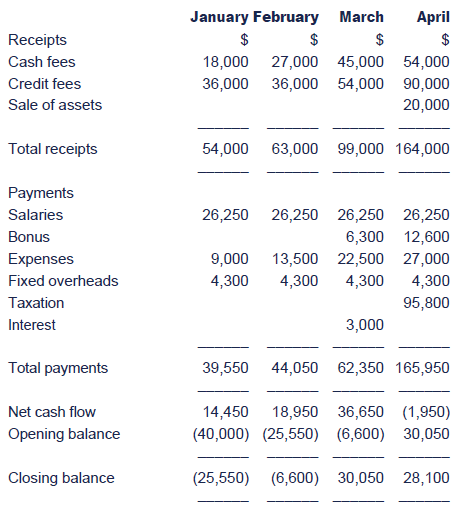
Workings
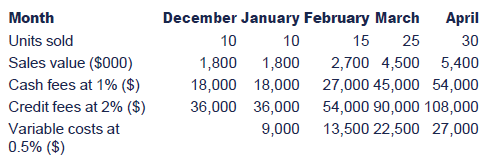
Monthly salary cost = (35,000 × 9)/12 = $26,250
Bonus for March = (25 – 20) × 140 × 9 = $6,300 Bonus for April = (30 – 20) × 140 × 9 = $12,600.
(b)The number of properties soldeach month indicates that Thorne Co experiences seasonal trends in itsbusiness. There is an indication that property sales are at a low levelin winter and increase as spring approaches. A proportion of any cashsurplus is therefore likely to be short-term in nature, since some cashwill be required when sales are at a low level. Even though net cashflow is forecast to be positive in the January, the month with thelowest level of property sales, the negative opening cash balanceindicates that there may be months prior to December when sales are evenlower.
Short-term cash surpluses should be invested with no risk ofcapital loss. This limitation means that appropriate investments includetreasury bills, short-dated gilts, public authority bonds, certificatesof deposit and bank deposits. When choosing between these instrumentsThorne Co will consider the length of time the surplus is available for,the size of the surplus (some instruments have minimum investmentlevels), the yield offered, the risk associated with each instrument,and any penalties for early withdrawal. A small company like Thorne Co,with an annual turnover slightly in excess of $1m per year, is likely tofind bank deposits the most convenient method for investing short-termcash surpluses.
The company must also consider how to invest longer-term surpluses.As a new company Thorne Co is likely to want to invest surplus funds inexpanding its business, but as a small company it is likely to find fewsources of funds other than bank debt and retained earnings. There istherefore a need to guard against capital loss when investing cash thatis intended to fund expansion at a later date. As the retail propertymarket is highly competitive, investment opportunities must be selectedwith care and retained earnings must be invested on a short- tomedium-term basis until an appropriate investment opportunity can befound.
(c)In two of the four months of thecash budget Thorne Co has a cash deficit, with the highest cash deficitbeing the opening balance of $40,000. This cash deficit, which hasoccurred even though the company has a loan of $200,000, is likely to befinanced by an overdraft. An advantage of an overdraft is that it is aflexible source of finance, since it can be used as and when required,provided that the overdraft limit is not exceeded. In addition, ThorneCo will only have to pay interest on the amount of the overdraftfacility used, with the interest being charged at a variable rate linkedto bank base rate. In contrast, interest is paid on the full $200,000of the company's bank loan whether the money is used or not. Theinterest rate on the overdraft is likely to be lower than that onlong-term debt.
A disadvantage of an overdraft is that it is repayable on demand,although in practice notice is given of the intention to withdraw thefacility. The interest payment may also increase, since the company isexposed to the risk of an interest rates increase. Banks usually ask forsome form of security, such as a floating charge on the company'sassets or a personal guarantee from a company's owners, in order toreduce the risk associated with their lending.
(d)The Baumol model is derived fromthe EOQ model and can be applied in situations where there is aconstant demand for cash or cash disbursements. Regular transfers aremade from interest-bearing short-term investments or cash deposits into acurrent account. The Baumol model considers the annual demand for cash(D), the cost of each cash transfer (C), and the interest differencebetween the rate paid on short-term investments (r1) and the rate paid on a current account (r2), in order to calculate the optimum amount of funds to transfer (F). The model is as follows.
F = ((2 × D × C)/(r1 – r2))0·5
By optimising the amount of funds to transfer, the Baumol modelminimises the opportunity cost of holding cash in the current account,thereby reducing the costs of cash management.
However, the Baumol model is unlikely to be of assistance to ThorneCo because of the assumptions underlying its formulation. Constantannual demand for cash is assumed, whereas its cash budget suggests thatThorne Co has a varying need for cash. The model assumes that eachinterest rate and the cost of each cash transfer are constant and knownwith certainty. In reality interest rates and transactions costs are notconstant and interest rates, in particular, can change frequently. Acash management model which can accommodate a variable demand for cash,such as the Miller-Orr model, may be more suited to the needs of thecompany.


 17. Exchange rate systems
17. Exchange rate systems
Key answer tips
This question is standard bookwork. It is vital that you discuss the implications of each system to multinationals.
Managed floating exchange rate
A managed floating exchange rate will be mainly influenced by themarket supply and demand for a currency, but is also subject tointervention by the relevant government. The government will buy or sellthe currency in order to influence the exchange rate, often to keep itwithin a desired range against the dollar or other key currency. Thegovernment will not normally reveal how or when it will intervene in theforeign exchange market, and floating exchange rates such as this aredifficult to forecast as they directly respond to economic events,relevant new information and to government intervention. This could leadto volatility in foreign exchange rates, which might be a deterrent toforeign trade.
In theory, managed exchange rates should gradually adjust tochanging economic relationships between nations. For example, as acountry moves into a balance of trade deficit, this would normally leadto a fall in the value of the country's currency, which in turn willmake the country's exports more attractive, and will reduce the tradedeficit. Floating exchange rates should prevent persistent deficits, andresult in fewer large speculative international movements of funds.From a multinational company's perspective the difficulty in forecastingsuch rates makes accurate cash budgeting for international activitiesmore onerous, increases currency risk, and in many cases makes some formof currency hedging essential.
Fixed exchange rate linked to a basket of currencies
An economy that fixes its exchange rate against the dollar or othermajor currency will inevitably be affected by the state of the economyand the policies of the country to which it has linked. For example, ifinflation or the money supply increases in the USA, similar effects maybe experienced in countries which have their currencies tied to thedollar.
An exchange rate linked to a basket of currencies is lesssusceptible to economic influences from a single country, although ifthe basket is weighted by international trade, a dominant trade partnermight still have a major influence. In theory, fixed exchange ratesoffer greater stability, and future rates should be easier to forecast,which reduces risk and aids international pricing and cash budgeting.However, fixed exchange rates do not remain fixed forever; devaluationor revaluation may occur if inflation, interest rates and other economicvariables diverge between the relevant countries. The direction of apossible change in rates is quite easy to predict, but not the exacttiming of devaluation or revaluation, or the magnitude of any change incurrency values. Fixed rates are also more susceptible to currencyspeculation.
Fixed exchange rates backed by a currency board system
This type of exchange rate regime shares many characteristics ofother fixed exchange rate systems, but the currency board means that anydomestic currency issues are backed by an equal amount of some 'hard'currency, such as the dollar. In theory the domestic currency could beconverted at any time into the hard currency at a fixed exchange rate.This backing by a 'hard' currency is aimed at achieving greater economicstability, and less exchange rate volatility. A currency board systemmight result in a fall in the domestic money supply, high interestrates, and thus high 'local' financing costs for multinationalcompanies. For some countries, such as Hong Kong SAR, a currency board hasproved successful. For others, such as Argentina, it has failed. Amultinational company will normally experience lower inflation and morestable economic conditions when a currency board exists.


 18. Toytown
18. Toytown
(a) (i) Economic risk
Economic risk is the variation in the value of the business (i.e.the present value of future cash flows) due to unexpected changes inexchange rates. It has a long-term impact.
For an export company it could occur because:
- the home currency strengthens against the currency in which it trades
- a competitor's home currency weakens against the currency in which it trades.
Toytown would face problems if the Australian dollar strengthensagainst the other local currencies. The company would then have toconsider either decreasing the profit margin on products, or increasingthe sales price to maintain profit levels. The second option couldresult in a loss of sales. The likelihood of this would be increased ifToytown faced more competition from local companies who are not exposedto the same risk.
Translation risk is an accounting risk rather than a cash-basedone. It arises when the reported performance of an overseas subsidiaryis translated into the home-based currency terms in order that they canbe consolidated into the group's financial statements and is distortedbecause of a change in exchange rates.
Unless managers believe that the company's share price will fallas a result of showing a translation exposure loss in the company'saccounts, translation exposure will not normally be hedged. Thecompany's share price, in an efficient market, should only react toexposure that is likely to have an impact on cash flows.
In the case of Toytown, if the subsidiary company wereestablished, a variation in the Australian dollar to US dollar exchangerate would cause a variation in the reported valuation of thesubsidiary. For example, if the Australian dollar strengthened againstthe US dollar, the reported value of the subsidiary would decrease.
Transaction risk is the risk of an exchange rate changing betweenthe transaction date and the subsequent settlement date, i.e. it is thegain or loss arising on conversion. This type of risk is primarilyassociated with imports and exports. If a company exports goods oncredit then it has a figure for receivables in its accounts. The amountit will finally receive depends on the foreign exchange movement fromthe transaction date to the settlement date.
Transaction risk has a potential impact on the cash flows of a company. The degree of exposure involved is dependent on:
- the size of the transaction (is it material?)
- the time period before the expected cash flows occurs
- the anticipated volatility of the exchange rates.
In the case of Toytown, if the Australian dollar strengthensagainst the US dollar during the six weeks before it pays the supplierfor purchases from the USA, the company will make a gain. If theAustralian dollar strengthens against local currencies before it is paidby customers, the company will make a loss.
(b) (i) Leading and lagging
Leading and lagging are means used to alter the time periodbetween the transaction and settlement dates to avoid exchange ratelosses or increase the likelihood of a gain.
If an exporter expects that the currency it is due to receive willdepreciate over the next few months, it may try to obtain paymentimmediately, perhaps by offering a discount for immediate payment. Thisis leading.
Lagging is an attempt to delay payment if the importerexpects that the currency it is due to pay will depreciate. This may beachieved by agreement or by exceeding credit terms.
Strictly speaking this is not hedging the exposure, it isspeculation. The company only benefits if it correctly anticipates theexchange rate movement.
When a company has receipts and payments in the same foreigncurrency due at the same time, it can simply match them against eachother. It is then only necessary to deal on the foreign exchange (forex)markets for the unmatched portion of the total transactions.
Where a firm has regular receipts and payments in the samecurrency, it may choose to operate a foreign currency bank account. Thisoperates as a permanent matching process and the exposure to exchangerisk is limited to the net balance on the account.
The scope for matching is limited unless there are flows in both directions.
(iii)Forward exchange contracts
Forward exchange contracts are the most frequently used method ofhedging. Such a contract is a binding agreement to buy or sell currencyat a fixed future date for a predetermined rate, the forward rate ofexchange.
Advantages are that companies have flexibility with regard to theamount to be covered and that the contracts are relativelystraightforward both to comprehend and to organise. The agreement on afixed rate eliminates downside risk.
However there are disadvantages – the company makes acontractual commitment that must be completed on the due date and has noopportunity to benefit from favourable movements in exchange rates.They are not available in all currencies.
Options are similar to forwards, but with one key difference –they give the right, but not the obligation, to buy or sell currency atsome point in the future at a predetermined date. A company cantherefore exercise the option if it is in its interests to do so, or letit lapse if the spot rate is more favourable or there is no longer aneed to exchange currency.
The advantage of options is that they eliminate downside risk butallow participation in the upside. Options are most useful when there isuncertainty about the timing of the transaction, or when exchange ratesare very volatile.
However the additional flexibility comes at a price – a premiummust be paid to purchase an option, whether or not it is ever used.
(c)Factors which Toytown will need to consider include:
- the cost of different options, for example, this would be lower for a forward exchange contract than for currency options
- the expertise of staff and the capacity of the company's management to arrange and manage different means of hedging
- whether receipts and payments in US dollars are likely to coincide enough for them to be matched
- how reliably the company can predict payment dates from customers – they have control over payment dates to the US supplier
- the likely volatility of exchange rates – the company needs to try to predict them as accurately as possible
- the availability of different methods – whether all products are available for all currencies.
If the company does set up a subsidiary as planned, then it may bepossible to match US dollar transactions if these become stable andpredictable. However, in the early stages of a new business they arelikely to be less predictable and matching may not be possible.
At the current time the company is able to forecast the timing ofreceipts and payments so forward contracts are likely to be the mostsuitable method. They should be available in most of the currencies thecompany deals in and are easy for staff to understand.
If in the future cash flows become uncertain, the company may want to reconsider the use of currency options.
(d)A forward rate agreement is anover-the-counter agreement between a bank and a customer. A customer canbuy an FRA to fix the interest rate for a short-term loan starting at afuture date. The FRA relates to a specific borrowing period. In theexample given in the question the company can borrow for a period of 6months starting in 2 months time at a simple annual interest rate of5.0%. This locks the company into an effective interest rate of 5.0%whatever the market rate.
The company enters into a normal loan but independently organises a forward with a bank:
- interest is paid on the loan in the normal way
- if the interest is greater than the agreed forward rate, the bank pays the difference to the company
- if the interest is less than the agreed forward rate, the company pays the difference to the bank.
The FRA:

In this case Toytown is protected from a rise in interest rates,but is not able to benefit from a fall in interest rates – it islocked into a rate of 5%. The FRA hedges the company against both anadverse movement and a favourable movement.


 19. PSBR
19. PSBR
(a)A country's balance of paymentsis the balance between its total imports and total exports. The levelsof imports and exports include both visibles (goods) and ‘invisibles'(services and movements of funds).
When imports exceed exports in any period, this is known as a‘trade deficit', and when exports exceed imports this is known as a‘trade surplus'.
The Public Sector Borrowing Requirement (PSBR) is the amount bywhich government spending exceeds government revenues in any accountingperiod. If the PSBR is negative it is referred to as the PSDR (PublicSector Debt Repayment).
During the mid 1980s the UK had a PSDR, but in recent yearsfalling tax receipts and increasing unemployment benefit payments haveresulted in a significant PSBR.
The balance of payments and the PSBR are connected by some common economic factors:
If a country experiences high levels of demand pull inflation thenone way of seeking to control this problem is to raise short terminterest rates. This has the effect of reducing the money supply andhence the demand for goods and services. If this happens the level ofimports is likely to fall, but also, as the economy slows down, thegovernment tax revenues will fall.
If the pound falls in value against other currencies this willmake imports more expensive and exports cheaper. In the long term theeffect of this should be an improvement in the balance of paymentsposition.
As imports are more expensive, however, this may also lead tohigher inflation. The government may seek to control this by eitherraising interest rates or increasing the tax burden, either of whichwould affect the PSBR.
The World Bank provides assistance in the form of financial aid tocountries with severe balance of payments problems. The aid is nearlyalways linked, however, to a devaluation of the currency and an increasein domestic interest rates, both of which are designed to stabilise thecurrency.
(b)A major refurbishment of apublicly funded hospital could be financed from increased taxation orreduced spending on other areas of government activity, or by increasinggovernment borrowing.
Increased taxation or reduced spending on other areas of activitywould not result in an increase in the PSBR, as it is simply a transferof funds from one part of the economy to another. If the governmentfinances the major refurbishment from increased borrowing however, thiswould result in an increase in the PSBR.
(c)A publicly funded hospital thatfinds that its funds are to be reduced must either reduce itsexpenditure, or increase its income from elsewhere, or undertake acombination of these two.
If neither course of action is undertaken then the hospital willaccumulate an increasing deficit which may infringe the hospital'soperating regulations.
Expenditure reduction methods include:
(i)Cancelling non-urgentoperations, closing down certain wards for a period of time, or allowingcertain waiting lists to lengthen. The difficulty with this course ofaction is that the problems may only be postponed to a future date, andthe result of this policy may not be acceptable in relation togovernment targets.
(ii) Applying modern managementaccounting techniques aimed at improving the economy, efficiency andeffectiveness of the services provided.
Income raising methods include:
(i)Generation of income from theprivate use of surplus resources e.g., offering the use of unused wardsfor private healthcare patients.
(ii) Fund-raising campaigns to provide resources for certain specified projects.
(iii)The sale and leaseback of land and buildings where government regulations permit.
(iv)Offering ancillary services in hospitals for which people would be expected to pay e.g. shops, catering services, etc.


 20. G Brown
20. G Brown
(a) Factors to consider when choosing between debt and equity:
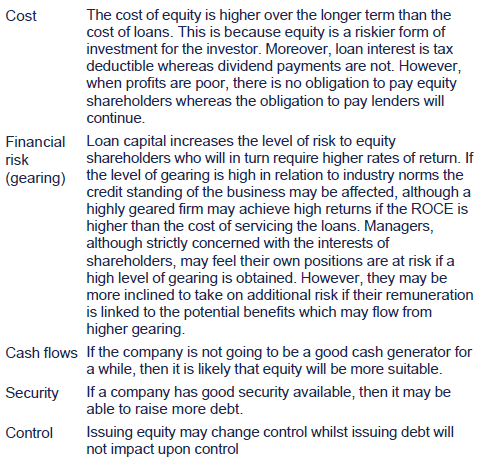

(b) Convertible loan stock provides the investor with the right,but not the obligation, to convert the loan stock into ordinary sharesat a specified future date and a specified price. The investor will onlyexercise this option if the market value of the shares is above the'exercise price' at the specified date. The investor will change statusfrom that of lender to that of owner when the option to convert isexercised.
The main benefit to the investor is that if the company issuccessful the investor will be able to participate in that success.This participation is not possible with straight debt. For the investorthen, convertible loan stock offers the best of both worlds –relatively low risk debt, but with participation in a successfulcompany. Because of this finance is relatively easily raised.
If the company is successful, the convertible loan stock will beself-liquidating, which can be convenient for the company. The companymay also be able to negotiate lower rates of interest or fewer loanrestrictions because of the potential gains on conversion.
Convertible loan stock is often used in takeover deals. The targetcompany shareholders may find this form of finance attractive if theyare uncertain as to the future prospects of the combined business. Theinvestors will be guaranteed a fixed rate of return and, if the combinedbusiness is successful, they will be able to participate in thissuccess through the conversion process. However, convertible loan stockcan be viewed as part loan and part equity finance, and some investorsmay find it difficult to assess the value to be placed on suchsecurities.
(c) When deciding to grant a loan, the following factors should be considered:
Purpose of the loan
Lenders will want to know what the loan is for, and the likely returns from the finance provided.
Security
Investors will want to take a charge over the assets of thecompany as security for the loan. They will ensure that the company hasassets available for security. If not, the interest charged will behigher.
The ability of the borrower to repay
The finance providers will check the credit history of thecompany as well as forecast financial statements to ensure theirinvestment is safe. They will use the services of a credit referenceagency (e.g. Dunn and Bradstreet) who will classify the companyregarding its credit risk.
The character and integrity of senior managers
Finance providers will want to know that the company is well runbefore investing in a company. The senior management team should havethe skills necessary to ensure, as far as possible, the success of theinvestment.


 21. Bestlodge
21. Bestlodge
Report
To Managing Director, Bestlodge
From A Consultant
Date Today
Subject Evaluation of financing alternatives for Bestlodge
Contents
(1)Terms of reference
(2)Floating rate loan
(3)Euro currency loan
(4)Rights issue
(5)Alternative sources of finance
(6)Conclusions and recommendations
(1) Terms of reference
The following report will evaluate the impact of each source of finance in terms of its:
(i)cost
(ii) risk
(iii)impact upon other suppliers of capital.
A number of alternative sources of finance are briefly discussed. Iwould be pleased to provide more details of these upon request. Arecommendation is made on the most suitable of the sources of financeyou are currently considering.
(2) Floating rate loan
(1) Cost
Debt finance is relatively cheap particularly if the company is ina position to offset the interest charge against taxable profits.
(2) Risk
The interest rate is variable and it could rise if generalinterest rates move upwards. On the other hand, if interest rates fall,it ensures that Bestlodge is not left with a high-cost loan. Floatingrate loans make cash budgeting difficult, but as variation in interestrates tends to be related to inflation rates the firm should find thatincreases in interest costs are partly matched by increases in operatingcash flows due to higher inflation.
The loan is only for five years. If the project has not generatedsufficient cash to repay the principal in this time, a further source offinance will be required. The availability of further funds in fiveyears' time should be considered.
The loan will, at least initially, substantially increase thefirm's gearing. In book value terms the likely effect is as follows:

Tutorial note
Other gearing measures would be acceptable. One particularlyuseful approach could be to calculate gearing on market values of debtand equity.
This increase in gearing is also reflected in the firm's interest coverage:

The acceptability of these increases will largely be determined byindustry standards and the firm's debt capacity. However, the loanappears to increase significantly the financial risk of the firm.
The existing loan notes will need to be redeemed in the near future and the firm should consider how this is to be financed.
(3)Impact upon other suppliers of capital
Equity: The increase in gearing will increase the risks taken by equity holders.
Earnings per share (EPS) is, however, likely to increase. This would also improve dividend cover.
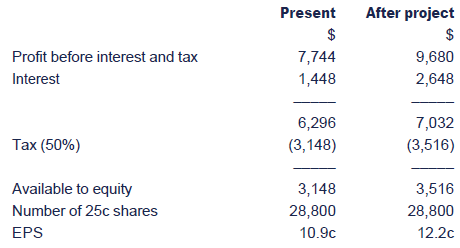
Debt: The increase in gearing, depending upon the quality of theassets supporting the new loan and the debt covenants involved, couldincrease the risks of the existing debenture holders.
(3)Euro currency loan
Many of the comments made regarding the above loan are also applicable. In addition, the following points should be considered.
Although this is a fixed rate loan, any changes in the €/$exchange rate could significantly affect its cost. The $ appears toweaken on the forward market in the coming year by approximately

This would increase interest and principal repayments by 6% pa. Ifthis trend continues it could add significantly to the cost of theloan. For example, if we assume a $ depreciation of 6% pa, then thiswould increase the actual pre-tax cost of the loan to
7% (1.06) + 6% = 13.42%
(Effect on interest) + (Effect on principal)
This would then be an expensive source of finance. It also addsforeign exchange risk to the substantial financial risk (gearing) beingtaken by the firm.
(4)Rights issue
To raise $12 million at current market prices the number of new shares required will be approximately

(1)Cost
As equity holders normally demand higher returns than debtinvestors, this will be a relatively expensive source of finance. Ifthese returns are not earned, share price would fall.
Issue costs would probably be larger than the arrangement costs on the debt finance.
(2)Risk
This is permanent finance and will not bring the pressure of early repayment.
A rights issue should substantially reduce the firm's gearing level, from 48.9% to

There is a risk of undersubscription.
(3)Impact upon other suppliers of capital

This represents only a marginal increase over existing EPS. Thismust be contrasted with the higher returns from the higher riskfinancing strategies
(5) Alternative sources of finance
This is a long-term investment and should normally be financed by long-term funds. Possible sources include:
(6) (i)mortgage loan through an insurance company or pension fund
(ii) debenture or convertible loan stock
(iii) leasing, or sale and leaseback
(iv) venture capital
(v) Eurobond or foreign bonds.
(7) Conclusions and recommendations
- Each source of finance has its own advantages and disadvantages.
- Gearing would probably rule out a debt issue.
- On the figures available the rights issue looks the safest option. Much depends on the current state of the stock market, and the likely reception of a rights issue.
- A mixture of equity and debt could be raised to balance gearing and EPS.
- Plans for the redemption of the existing loan notes should be considered.
- Issue costs, particularly on a rights issue, should be considered.


 22. Cherry Tree Company
22. Cherry Tree Company
(a) TERP
Market value (MV) of shares in issue = 300,000 × $4.40 = $1,320,000
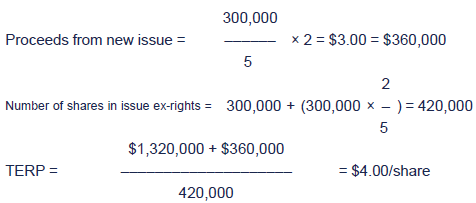
Note: that the calculation can be done on the value of thewhole equity or on the basis of the minimum shareholding needed toacquire one extra share:

The chairman is correct. The shareholder should either exercise the rights or sell them (subject to (d) below).
(1) Take up his rights
Buy the new shares to which he is entitled. He can buy 400 newshares at $3.00, which will mean investing an additional $1,200 in thecompany.

The investor will now have an investment of 1,400 shares that in theory will be worth $5,600 ($4.00 per share).
The value of the total investment has gone up by $1,200, but thisis the amount of the additional investment he has made to acquire thenew shares, so his wealth is unchanged.
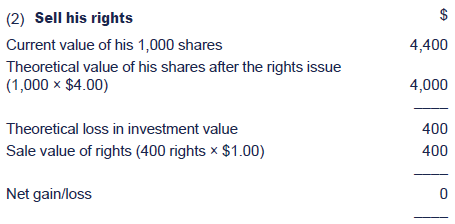
By selling his rights, the investor receives $400, but the valueof his investment is likely to fall by $400, leaving him no better andno worse off overall.
(3) Buys 200 shares and sells 200 rights
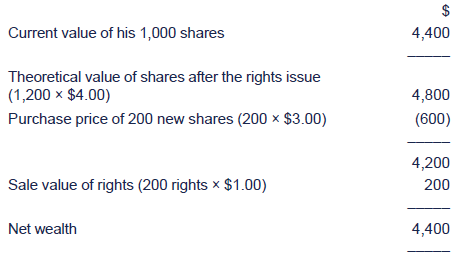
Again his overall wealth is unchanged.
(4) Take no action
If the investor takes no action, the value of his shares is likelyto fall from $4,400 before the rights issue to $4,000 after the rightsissue. Taking no action is therefore an inadvisable option, because itresults in a fall in investment value without any offsetting benefitfrom the sale of rights.
(d) Real circumstances to support the shareholder's claim
Reduction in wealth
It is possible that the shareholder, even though either exercisingthe rights or selling them, will suffer a reduction in wealth.
The above analysis is based on the assumption that the funds to beraised by the new issue of shares will be invested in the business toearn a rate of return comparable to the return on the existing funds.
The stock market, in valuing the shares of Cherry Tree after therights issue, has to make some assumption as to how profitably the newfunds are to be used.
For example, if the new funds were squandered, the overall returnon equity funds would fall and the price would drop below the $4.00calculated above.
Alternatively, if the sales are to be used to finance a highlyprofitable investment and the stock market does not initially appreciatethis point, then the market in arriving at a price of $4.00 ex-rightswould be undervaluing the shares. When the true earning potential of thecompany was realised, the share price would rise.
However, by then it may be too late for the shareholder referred to in the question.
If the shareholder exercises the rights in the circumstances justdescribed, he will not lose. When the shares rise in price he willbenefit. However, if at the time of the rights issue he decides to sellthe rights, he will lose.
The value of the right in the circumstances described is based onthe assumption that the new funds will earn as much as the old. Laterthe person who exercises the rights will benefit, when the shares risein price above that expected at the time of issue.
(e) Alternative methods of issuing equity finance
Placing
A placing is where an issuing house undertakes to find purchasersfor the shares and places the shares with these clients. Issue costs aremuch cheaper as there are no underwriting costs or prospectus costs.However, there are limitations on the amount of capital that can beraised using this method and shares tend to be placed in larger bundles.This will dilute the control of current shareholders as shares are morelikely to be placed with large financial institutions.
Offer for sale
Shares are sold to an issuing house which then offers the sharesfor sale to the general public either at a fixed price or by tender. Ifthe sale is by tender then a minimum price is set and the actual issueprice determined when all of the tenders have been received. The issuesare always underwritten and this fee is payable to the issuing house andwill vary with the degree of risk relating to the issue. There is norestriction on the amount of capital that can be raised using thismethod but issue costs are likely to be higher than a rights issue andexisting control may be diluted.
A public offer for subscription
Shares are sold directly to the public by the company. Issue costsare likely to be high as the company must advertise and administer theprocess. Specialist advisors are used to determine the issue price andunderwriting fees may be high. This method enables a company to access awider market for funds but they may not have the in house expertise toadminister the process and the issue costs may be prohibitively high fora relatively small issue of shares.


 23. M Co
23. M Co
(a) Calculation of weighted average cost of capital
Definitions:
K = weighted average cost of capital
ke = cost of equity capital
kd – cost of debenture capital
kL = cost of bank loan
E = Total ex-dividend market value of equity
D = Total ex-interest market value of debt
L = Total value of outstanding bank loan
(i)Calculation of ke
Assuming an underlying dividend growth of g per annum, the average growth rate between 20X4 and 20X8 is given by:
g = 6.4%
Assuming that shareholders take past dividend growth as areasonable approximation to future dividend growth, then using thedividend growth model,
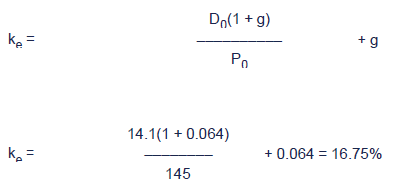
(ii) Calculation of kd
kd is the discount rate which equates the present value of futureincome ($7 per annum) and redemption ($100) to the current market price($83.60).

Therefore the required return of investors is 12.6%.
Note: this question states that taxation should be ignored.If this was not the case, the interest payments in years 1 – 4 shouldbe net of tax.
(iii)Calculation of cost of bank loan
The current cost of debt is taken as the best estimate of the future cost of debt, i.e. 8%.
Note: if the question included taxation, this rate should be reduced by (1 – T).
(iv)Calculation of the weighted average cost of capital
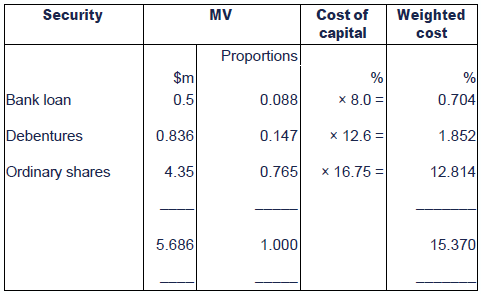
(b) Business risk and financial risk
The weighted average cost of capital should only be used as thetarget discount rate for appraising investment opportunities whoseacceptance will not alter the weighted average cost of capital.
Since the cost of any type of capital can be regarded as afunction of a risk-free rate and a risk premium, this implies that kshould not be used to evaluate opportunities which have significantlydifferent risk characteristics from the average risk borne by thecompany prior to acceptance of the project.
In this context, it is useful to separate the total risk of thecompany into business risk and financial risk. The business risk is therisk inherent in the nature of the company's operations. The financialrisk is a function of a company's gearing. For a project to be evaluatedusing k, its acceptance must not alter the company's overall businessrisk nor must it alter the financial risk. Therefore, it must be of asimilar nature to existing projects and it must be financed in such away that the gearing ratio is unchanged and hence the financial risk isunaltered. In practice may also be used to evaluate small or marginalprojects whose acceptance is unlikely to alter overall corporate risk.
(c) Advice to directors
The situation outlined in the question if such that the projectbeing considered could hardly be thought of as marginal. The cost of theproject ($3m) is nearly 70% of the existing market value of thecompany. In these circumstance k could only be used as a target discountrate if its business risk were the same as that of existing projectsand it were to be financed in the same way as existing projects. This isunlikely to be the case, and as a generalisation it is probably unwiseto use the existing k to evaluate such a major investment opportunity.


 24. Bacchante
24. Bacchante
(a)x(S = Step)
Combined cost of capital is as follows:
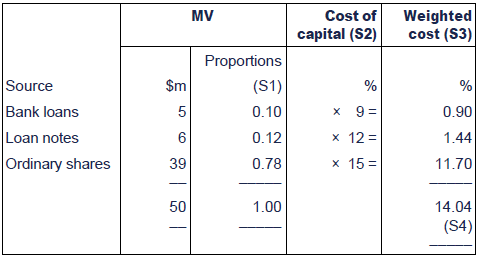

The return on the additional facilities at Cambridge is estimated to be:
Therefore:
(1)The proposal's return (IRR) is below current WACC and should be rejected.
(2)Note that current facilities atOxford appear to yield a very low return, though without more data (e.g.is capital employed at current valuation?) the significance of thisfact is difficult to evaluate.
Alternatively the WACC could be used to discount the Cambridgeproject:

Since the NPV is negative the project should be rejected.


 25. Kingswick
25. Kingswick
(a)Since Kingswick is all equity financed its cost of capital is the same as its cost of equity.
Assuming that Kingswick's cost of capital properly reflects its beta factor:
Ke = Rf + β ( Rm – Rf)
therefore:
18.5 = 8 + β(15 – 8)
10.5 = 7β
β = 10.5 ÷ 7 = 1.5
(b) & (c)
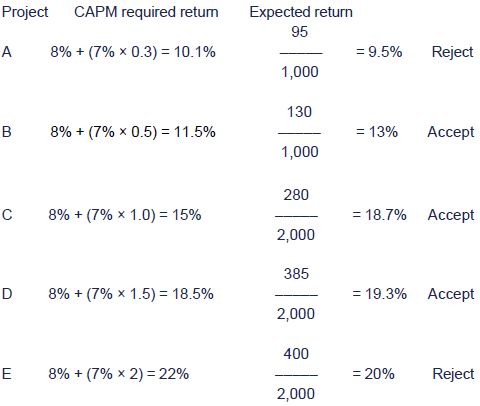
(d)If the projects were discountedat the company's cost of capital, 18.5%, then only those with yield ≥18.5% would be accepted, i.e. the company would accept C, D and E andreject A and B.
Using the firm's cost of capital is clearly wrong because it doesnot allow for the different risks of the projects. It is simply arequired rate of return given company risk at the time capital cost isevaluated. The projects where an incorrect decision would be made byusing the firm's cost of capital are:
Project B a valuable low risk project is incorrectly rejected.
Project E this would be accepted despite the fact that its return is not high enough to compensate for its high systematic risk.


 26. AB Co
26. AB Co
(a)The data collected by thefinance director supports Modigliani and Miller's (M&M) theory ofgearing (see workings below). This states that, in the absence oftaxation, a company's weighted average cost of capital (WACC) dependsonly on the risk of that company’s earnings (i.e. the level ofbusiness or earnings risk). In particular the WACC of a company in thesecircumstances is independent of its capital structure.
If one accepts these results, then AB Co would always be facedwith a WACC equal to its present WACC of 12%. The downward effect ofissuing cheaper debt finance (at 4%) on the WACC will always, aspredicted by M&M, be counteracted by an equal and opposite rise inthe cost of equity. This can be illustrated as follows for AB Co.
Consequently the discount rate that should be used for project appraisal is the WACC of 12%.
This assumes that the projects to be appraised will carry the same business risk as that from the existing operations of AB Co.
As an alternative to the above analysis it is also necessary toconsider briefly the implications of the traditional theory of gearing.This is best illustrated in its results by the following diagram.
Under the traditional theory of gearing the initial rise in equityas gearing increases is initially outweighed in the WACC calculation bythe introduction of cheaper debt finance. Eventually this effect isreversed and with the influence of bankruptcy risk (see below) even thecost of debt rises at high levels of gearing. The overall effect is toproduce a WACC that, for some optimal level of gearing, is a minimum.
If the data collected by the finance director are consistent withM&M purely by chance (i.e. the traditional theory is that whichactually describes the relationship between WACC and gearing), then ABCo should issue sufficient debt to attain its optimal gearing level(i.e. lowest WACC). At optimal gearing the associated minimum WACC willbe an appropriate discount rate for investment appraisal.
Workings:
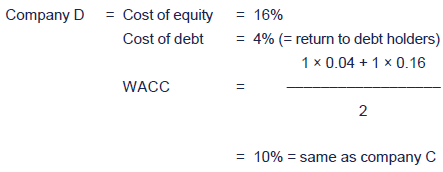
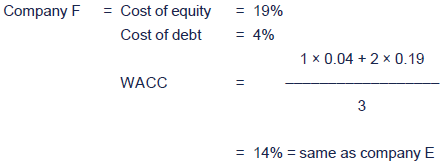
(b)Corporate taxes
If corporate taxes are introduced the effect is to produce a costof debt that is lower than the 4% return required by the providers ofdebt finance. This is on the assumption that companies in Zee can setinterest payments against profits for the purpose of computing tax, thusobtaining tax relief on such payments.
M&M predict that the effect on WACC will be as indicated below.
It can be seen that any increase in gearing will produce a lowerWACC. Thus, if one accepts M&M's hypothesis with corporation tax, ABCo would seek to gear as highly as possible (in practice investors willset an upper limit on borrowing). An appropriate discount rate forproject appraisal would be the WACC at the highest gearing level.
Considering the traditional theory of gearing with corporation tax,the effect of tax on the cost of debt is as described above. However,this will not change the basic result of the traditional theory (i.e.that there exists an optimal level of gearing) and again the minimumWACC will be used as a discount rate.


 27. PDQ Inc
27. PDQ Inc
(a)The company states itsobjectives as ‘to maximise shareholder wealth whilst recognising theresponsibility of the company to its other stakeholders.' Since we areonly given financial information in the question, we can only assesswhether the company has met its objectives with respect to itsshareholders and other financial stakeholders (suppliers, customers,employees, loan creditors and the government) and not to itsnon-financial stakeholders (journalists, the public, etc).
Consider first the shareholders.
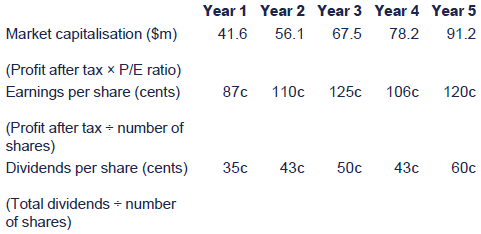
The share issue of $20m at the start of year 4 seems to havedisturbed the favourable trends in earnings and dividends per share forthat year. However the overall pattern looks very satisfactory over the 5year period; the company has succeeded in increasing shareholder wealthas it hoped.
By year 5 the share price stands at $91.2m/8m = $11.40 per share compared with only $41.6m/6m = $6.93 in year 1.
The other financial stakeholders can see their shares in the company's results as follows:
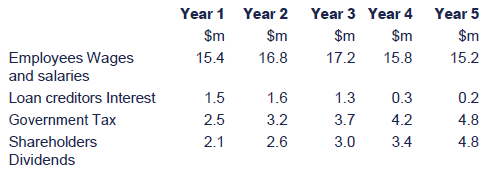
We can see that payments to employees fell substantially after year3, together with the absolute number of employees. The average wagesper employee has fallen since year 2, suggesting that the mix ofemployees is shifting towards less-skilled workers which could bringproblems in the future.

The loan creditors have received less interest payments in years 4and 5, but this arises purely because of the reduction in long-term debtmade possible by the rights issue at the start of year 4.
Conclusion
It appears that individual employees have received less of thefinancial benefits accruing to the company than the shareholders. Whilethe average wages per employee has fallen over the last four years(suggesting perhaps that certain senior employees have been maderedundant), dividends per share have risen substantially over the sameperiod.
It is not possible to judge, purely from the information available,whether the company has or has not met its objectives. The additionalinformation that would be helpful is discussed below.
(b)Other financial informationwhich would be needed to assess more accurately whether the company hasmet its objectives includes the following:
- What investment possibilities were rejected by management? The analysis above seemed to show that shareholders did well over the period, but was their return maximised, i.e. the best possible? To decide this it would be necessary to assess the alternative courses of action that were rejected during the course of the year; if any of these would have been more profitable than what was actually decided, then the shareholders' return was not the maximum possible.
- How did securities markets in general fare over the period? A shareholder should view his investment in shares in the company in the light of other returns available on similarly risked securities in the market. If better returns were available elsewhere at no more risk than the rational risk averse investor should dispose of their shares.
- What was the inflation rate over the period? Growth in money amounts of dividends and earnings might look less impressive if the trend is deflated by the inflation rate and only real increases are examined.
- Details of the company's workforce. Why has the payroll cost reduced in the last two years, by cutting wage rates or by losing high-paid employees? If there has been a formal programme of rationalisation and redundancies, an assessment of future prospects would be valuable.
- Volatility of share prices. We are given an average P/E ratio for each year, but how volatile has this and the share price been during each year? Companies should seek to reduce volatility by keeping markets informed so that analysts appreciate what the management are trying to do. This should support the share price.
- Amounts spent on environmental and social issues. A progressive company in today's business environment recognises its responsibilities to society on top of its other duties. Projects to ensure the minimum of pollution and support of local communities will serve to discharge these responsibilities.
- Amounts spent on employee communications and staff welfare would similarly support the good reputation of the company.


 28. Deerwood
28. Deerwood
Director A believes that investment should be financed byinternally generated funds, including retained earnings. This implies alow dividend payout or no dividend payout, probably with the amount ofdividend to be paid being treated as a residual after all investmentfinancing needs have been satisfied. The residual theory of dividends isbased upon the belief that investors will prefer the company to retainand reinvest earnings rather than pay dividends s as long as the returnon reinvested earnings is greater than the return investors could earnon other investments of similar risk. However if dividends are only paidafter all investment financing needs have been satisfied, the amount ofdividend paid is likely to fluctuate greatly depending upon the size ofthe investment budget for the year and the level of after tax earnings.If investors object to fluctuating dividends, in particular dividendreductions, the cost of equity is likely to be higher for a company thatadopts a residual dividend payout than a similar company with a morestable dividend payment pattern. Additionally a residual payout policymight lead to a company deviating from its target ('optimal') capitalstructure.
Arguments in support of a high level of retentions include:
(i)As the director suggests,raising external finance, especially new equity issues, can involvesubstantial issue costs which may be avoided by using retained earnings.
(ii) Capital gains may be taxedat a lower rate than dividends causing a positive preference byshareholders paying a high marginal tax rate for high levels ofretentions. In the United Kingdom, for example, capital gains anddividends are now taxed at the same marginal rate but there is annualexemption from tax which could to lead to a positive preference byindividual shareholders for a high level of retentions.
(iii)New equity issues mightdilute the control of the existing owners of the business; a high levelof retentions maintains the current pattern of control.
(iv)A faster rate of corporategrowth might be achieved by a policy of retaining a high level ofearnings (although corporate growth may also be achieved throughacquisitions and external financing).
The share price of a company will usually fall when the shares aretraded ex div. This is to be expected as part of the wealth of theshareholder is being paid in the form of a dividend rather than keptwithin the business. The fall in share price on the ex div date islikely to be approximately equal to the dividend per share to be paid(assuming that No other factors influence the share price at the time).
Director B presents some evidence from the USA which suggests thathigh marginal taxpayers prefer a low dividend payout and that lower ratetaxpayers prefer a relatively high dividend payout. The implication isthat Deerwood should identify the marginal tax rates of its shareholdersand adjust its dividend policy accordingly. The analysis of Deerwood'sshareholders shows that only 36-5% of shares are identified as beingheld by individuals, with an average holding of about 1,250 shares,although 'nominees' might include some other individuals. More than 42%of the shares are held by institutions which include both tax payinginstitutions and tax exempt institutions (e.g. pension funds).Deerwood's investors include individual investors and institutionalinvestors that are subject to different rates of tax. This could lead toconflicting desired dividend policies among investors. In suchcircumstances a compromise 'intermediate' pay-out ratio is sometimessuggested. The US survey, although supportive of a particular clienteleassociated with a particular dividend yield, might not be directlyrelevant to Deerwood's home country where the tax system with respect todividends and capital gains may be different from the US tax system.
Even if a clientele effect does exist there is little evidence thatthe market price of a company is influenced by its dividend policy.Modigliani and Miller suggest that 'each corporation would tend toattract itself a clientele consisting of those preferring its particularpayout ratio, but one clientele would be as good as another in terms ofthe valuation it would imply for firms'. It might be that Deerwood'sexisting dividend policy has attracted a clientele that is satisfiedwith that policy, and that the company's market value could not beincreased by changing the existing policy.
Director C is correct in stating that individuals and institutionalinvestors might require dividends to satisfy current incomerequirements (e.g. pension payments. life assurance payments). It isargued that although current income could be 'created' by selling asmall proportion of existing shareholdings such sales involvetransactions costs and dilute shareholdings, and are not a satisfactoryalternative to a dividend payout. High payouts are sometimes advocatedin countries where accounting information, particularly earningsinformation, is poor. In such circumstances dividends might give anindication of the profitability of companies.
The suggestion that investors prefer a known dividend to anuncertain capital gain is known as the 'bird in the hand' theory.Dividends are more predictable than capital gains. However, the risk ofthe company in the long run is determined by the investment andborrowing policies, and not by the dividend policy, and the company'soverall operating cash flows do not alter with dividend policy. Thepayment of dividends is not increasing the shareholders' wealth. As longas the market is efficient the share price will offer a total returnthat is high enough to compensate for the risk associated with the shareand its' uncertain capital gains'.
Director D supports the view that dividend policy is irrelevant tothe value of a company. The equation by Modigliani and Miller statesthat a company's value depends upon the expected future earnings stream,not upon current or future dividends. Dividends do not appear withinthe equation, and investment, profit, the price at time one, and thecapitalisation rate are all assumed to be independent of dividend, hencedividend policy is irrelevant. The equation relies on restrictiveassumptions including perfect capital markets, no transactions costs, agiven investment policy of the company which is not subject to change,and no taxes. Critics of Modigliani and Miller argue that marketimperfections and taxes alter this situation and make dividend policyrelevant to the value of the firm.
However, even when corporate taxes are introduced Black andScholes, and later Miller and Scholes, with both personal and corporatetaxes argue that dividend policy is irrelevant. Although there has been agreat deal of research into dividend policy, there is no conclusiveevidence regarding the impact of dividend policy on share valuation.


 29. Predator Co
29. Predator Co
(a) Net asset valuation
Target is being purchased as a going concern, so realisable values are irrelevant.

(b) DVM
The average rate of growth in Target's dividends over the last 4 years is 7.4% on a compound basis.
85 (1+g)4 = 113.1 hence g = 7.4%
The estimated value of Target using the DVM is therefore:

(c) P/E ratio method
A suitable PE ratio for Target will be based on the PE ratio of Predator as both companies are in the same industry.


A suitable PE ratio is therefore 15.02 × 0.80 = 12.02
(multiplying by 0.80 results in the 20% reduction).
Target's PAT + Adjustment for the savings in the director's remuneration after tax:
$183,000 + ($40,000 × 67%) = $209,800
The estimated value is therefore $209,800 × 12.02 = $2,521,796
Say $2.5m
(d) Advice to the board
On the basis of its tangible assets the value of Target is $1.4 million, which excludes any value for intangibles.
The dividend valuation gives a value of around $1.6 million.
The earnings based valuation indicates a value of around $2.5million, which is based on the assumption, that not only will thecurrent earnings be maintained, but that they will increase by thesavings in the director's remuneration.
On the basis of these valuations an offer of around $2 millionwould appear to be most suitable, however a review of all potentialfinancial gains from the merger is recommended. The directors should,however, be prepared to increase the offer to maximum price.


 30. Market efficiency statements
30. Market efficiency statements
The accuracy of each statement depends on which view of market efficiency is considered:
The EMH says that share prices are always right.
If 'right' means at a true value – an equilibrium priceincorporating all information available, then this is mainly true in astrong form efficient market. However, since the reaction to newinformation would not be instant, there will be a short period even in astrong market when the price is not 'right'.
In a semi-strong market the price will be fair (reflecting all publicly-available information) rather than right.
In a weak form efficient market, the price does not include all information.
This is because shares move in a random fashion when new information is made public.
Share prices do not move randomly when new information is announced– they move in a predictable fashion – up for good news and downfor bad. However they follow a 'random walk' in that each price changeis independent of the one that went before and it is not possible topredict the content of the new information without insider information.
In a strong form market, shares would not move just because theinformation had been publicly announced – the information would beincorporated as soon as the content of the news arose, e.g. at the pointthe directors decided to embark upon a particular investment.
The only reason prices move randomly is because of the new information contained in the accounts when they are published.
New information impacting share movements when announced can comefrom a variety of sources including announcements by management, changesin interest rates or exchange rates, dividend announcements, etc. In asemi-strong market it is likely that the majority of informationcontained in the published accounts is already known to the market andtherefore reflected in the share price. In this case, the share pricewould only react if the published accounts contained new or unexpectedinformation.
Both technical and fundamental analysis serve no function
In fact the analysts play a key role in reviewing information and communicating it quickly to the market.
They therefore help ensure the market remains efficient.
technical and fundamental analysis … cannot predict future share price
It is true that, in an efficient market, analysing informationalready in the public domain cannot help predict the future share price,as the share price will already reflect all the information beinganalysed.
Corporate fund managers cannot predict share prices either
There is a possibility that fund managers could predict futureshare prices in a semi-strong efficient market but only if they areoperating with inside information.

|
Created at 5/24/2012 4:21 PM by System Account
(GMT) Greenwich Mean Time : Dublin, Edinburgh, Lisbon, London
|
Last modified at 5/25/2012 12:54 PM by System Account
(GMT) Greenwich Mean Time : Dublin, Edinburgh, Lisbon, London
|
|
|
|
 |
Rating
:
|
 Ratings & Comments
(Click the stars to rate the page) Ratings & Comments
(Click the stars to rate the page)
|
 |
Tags:
|
|